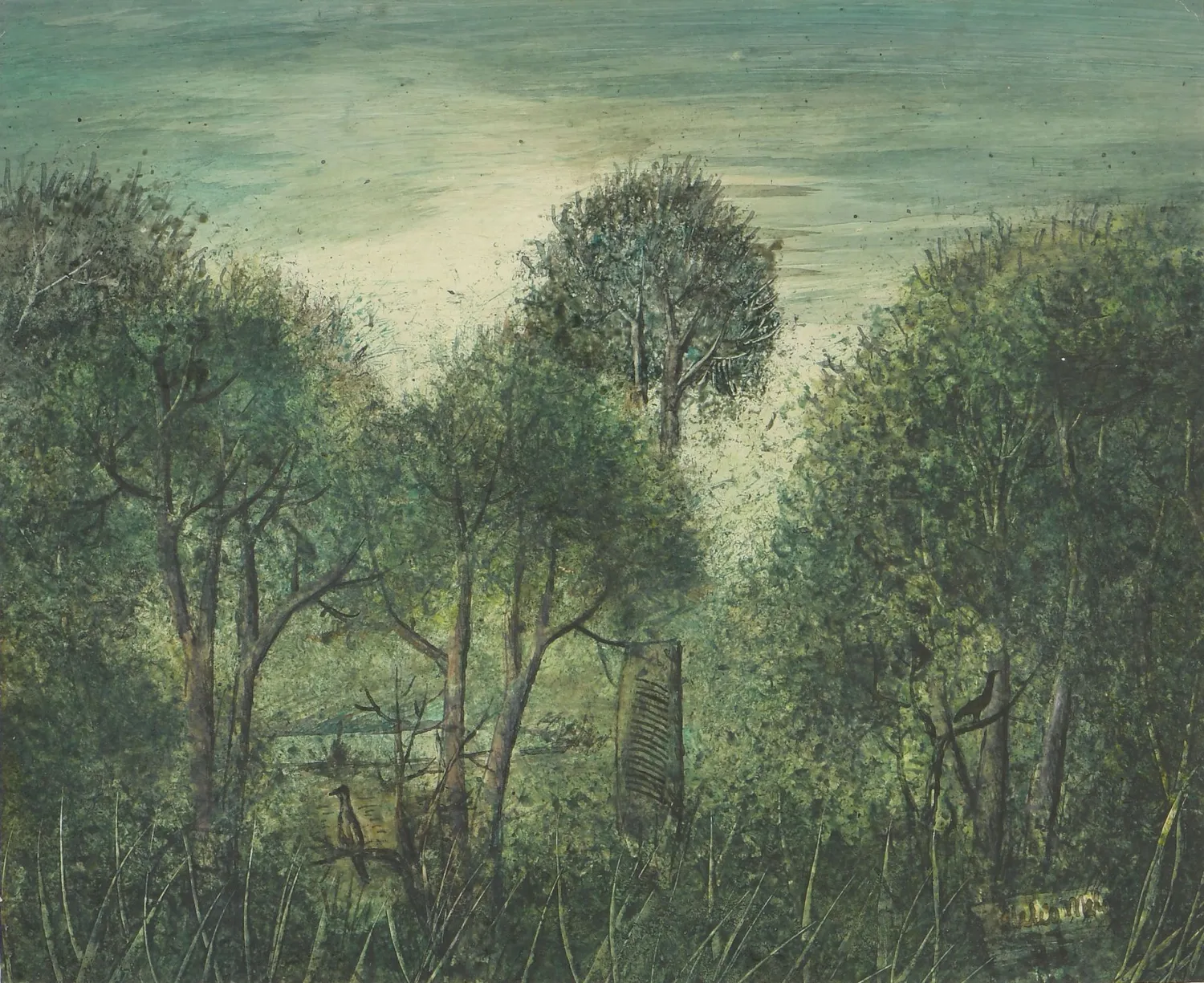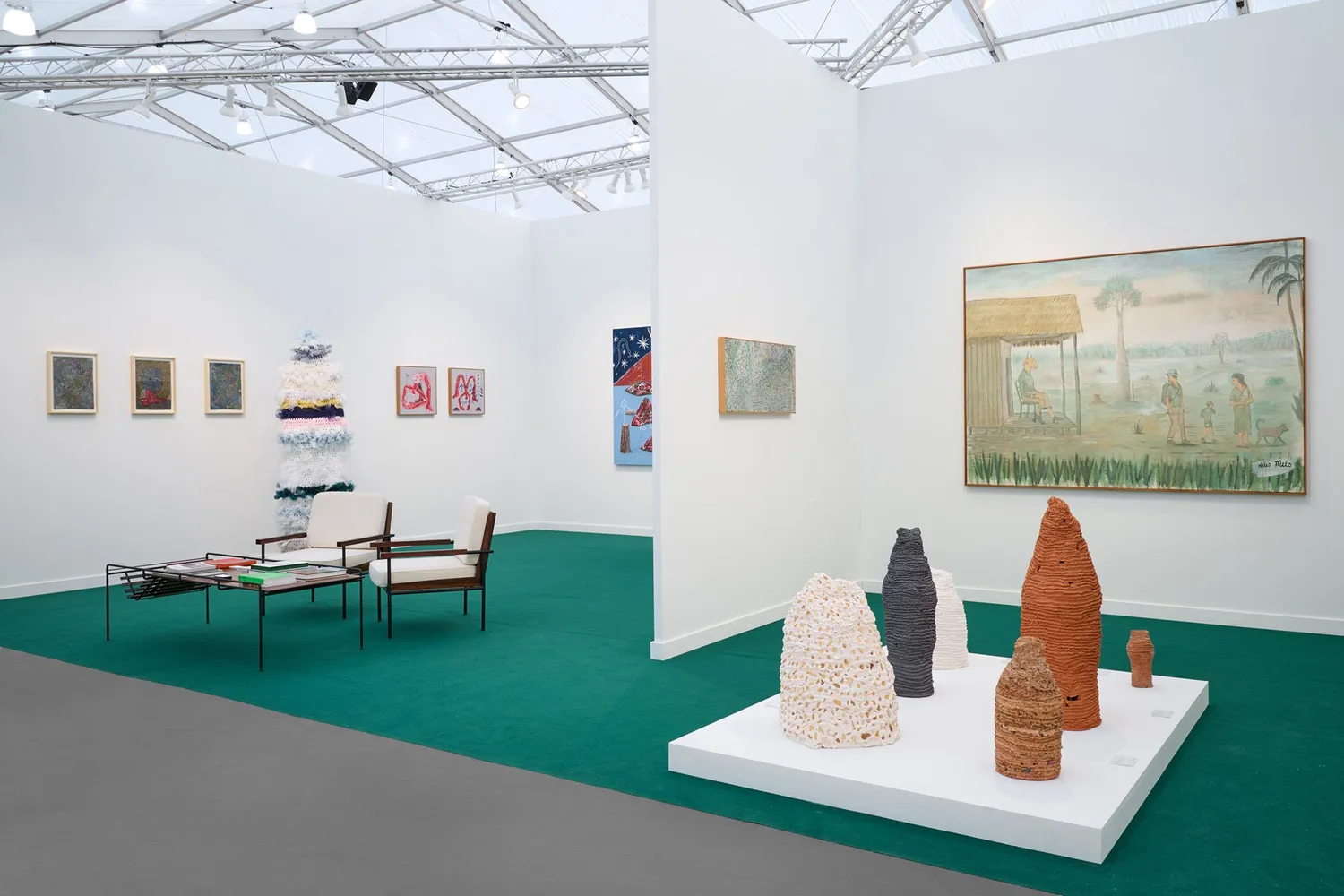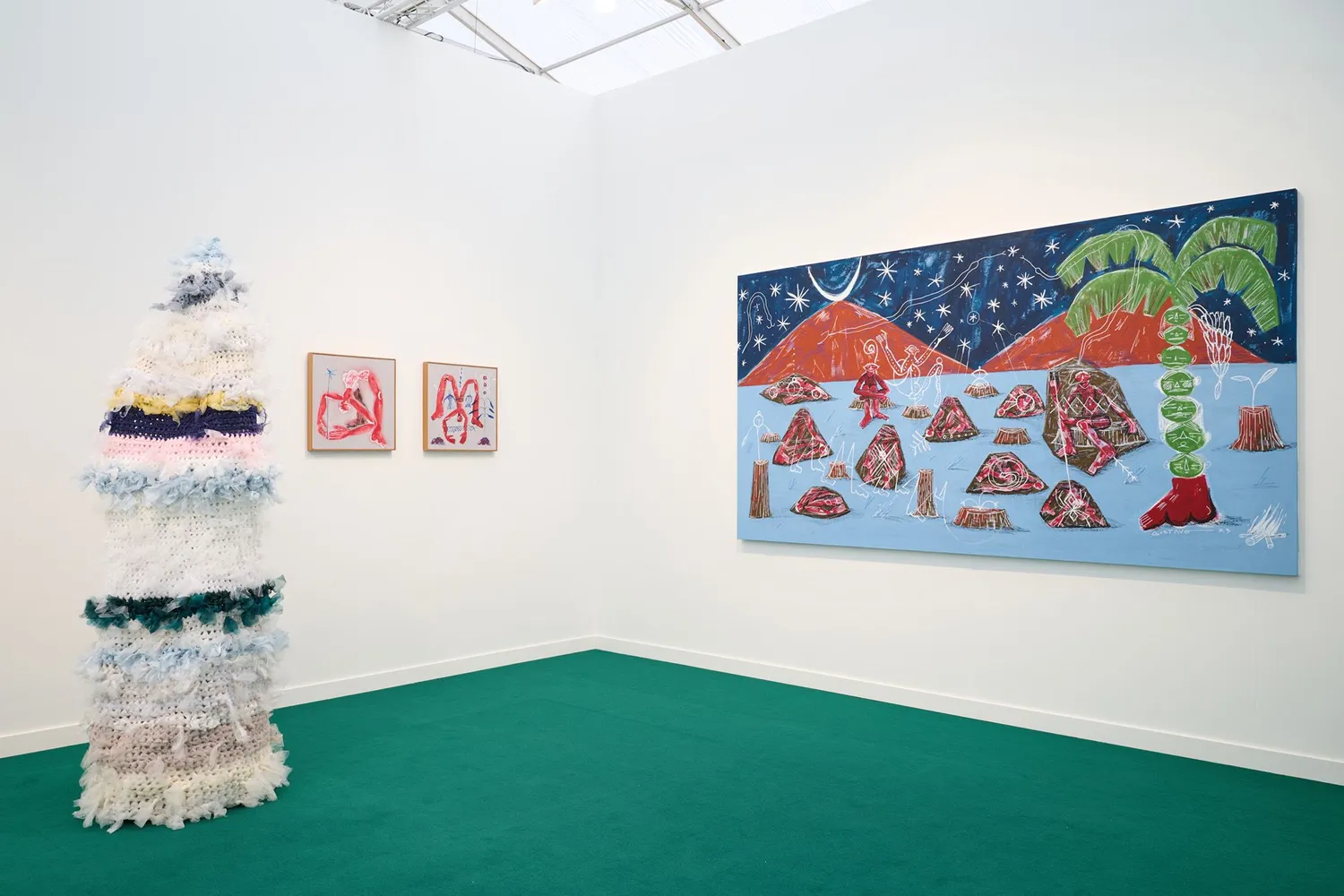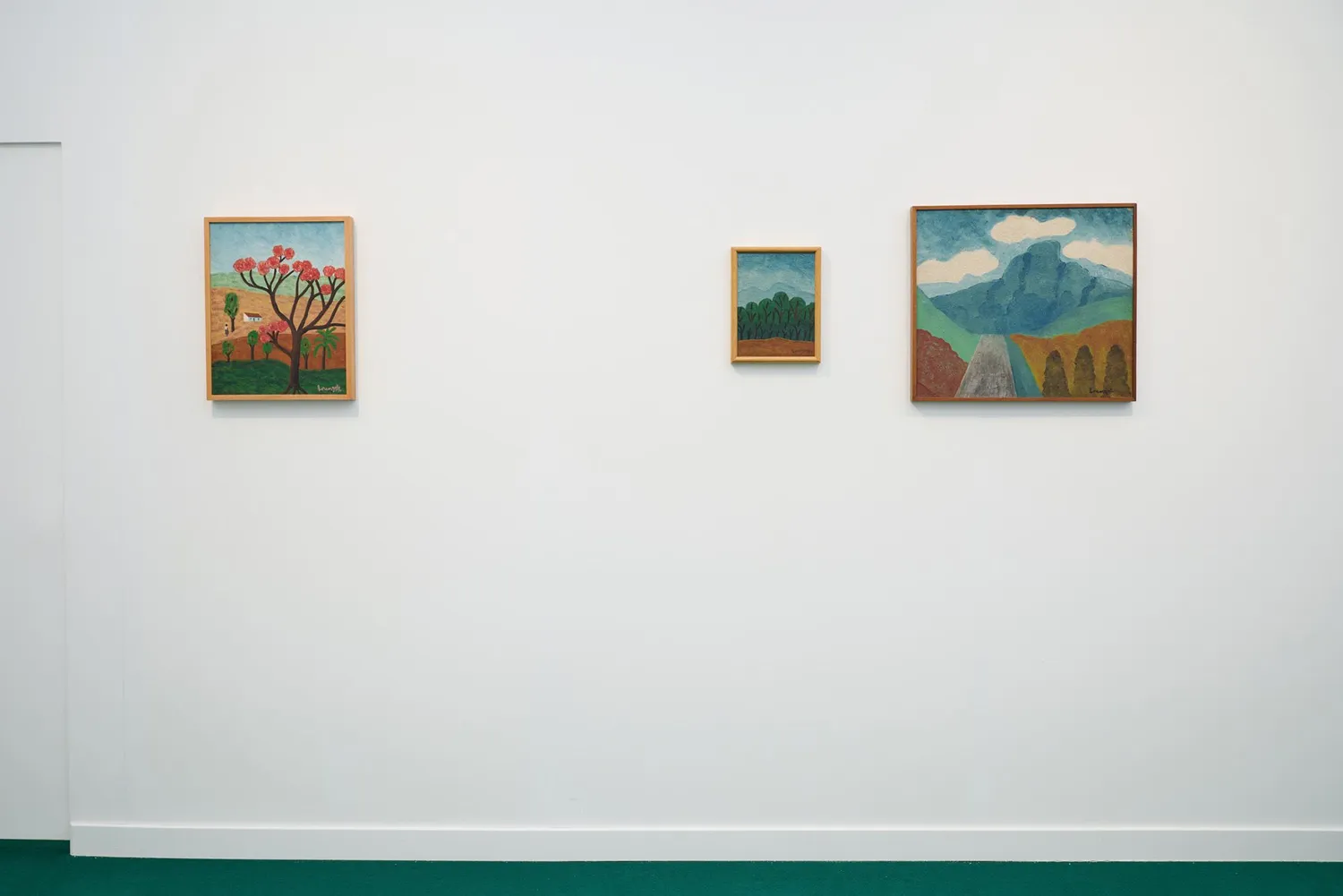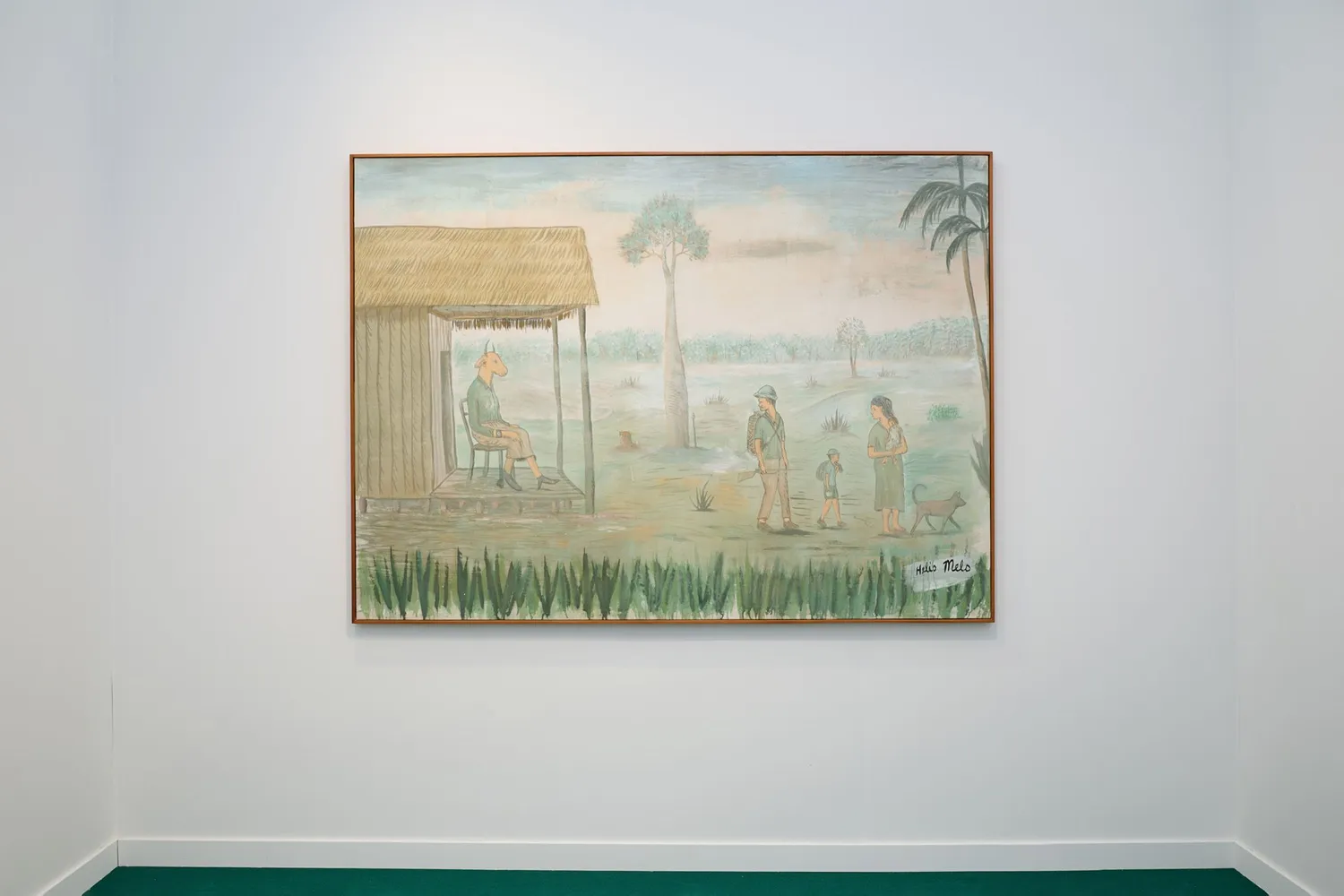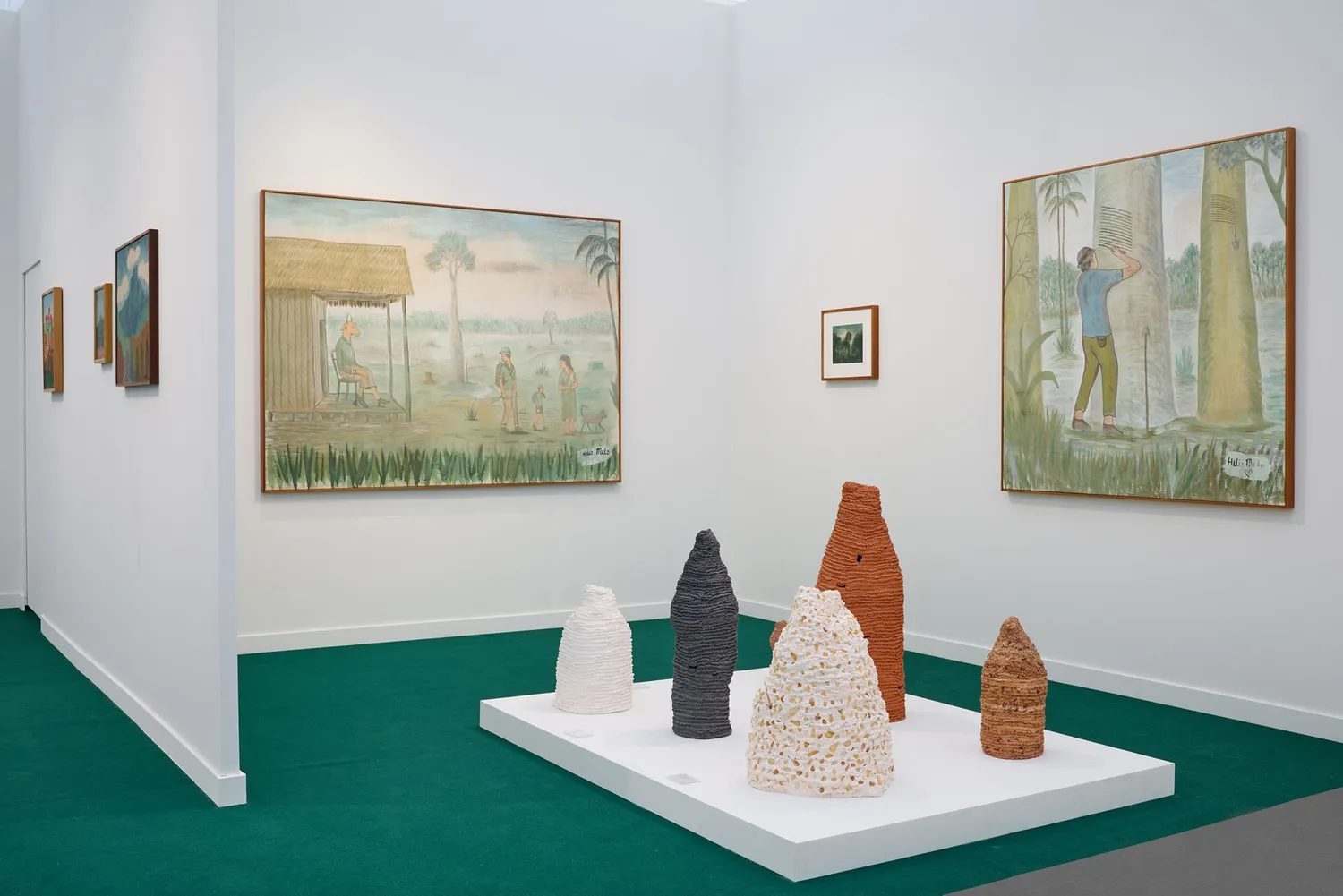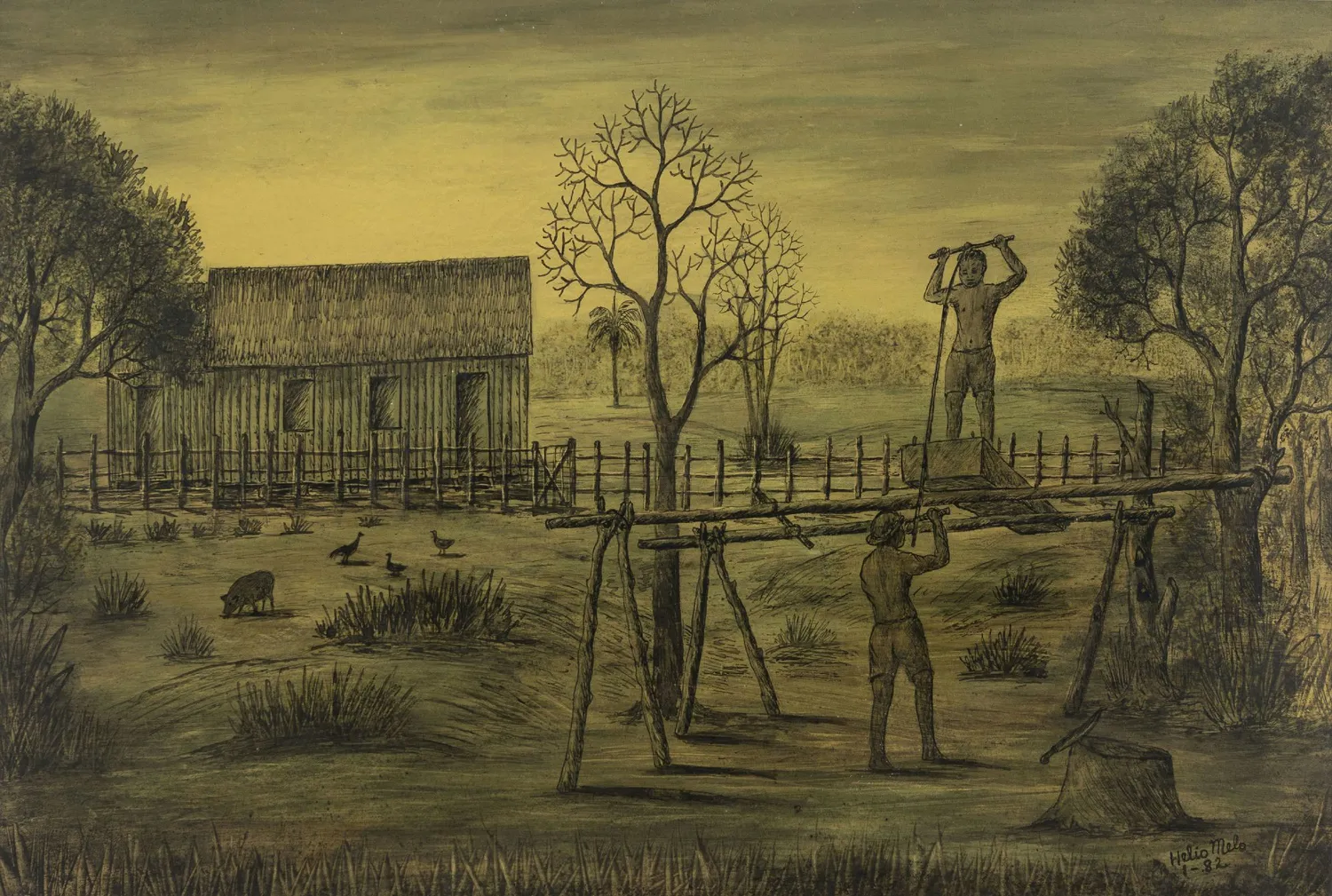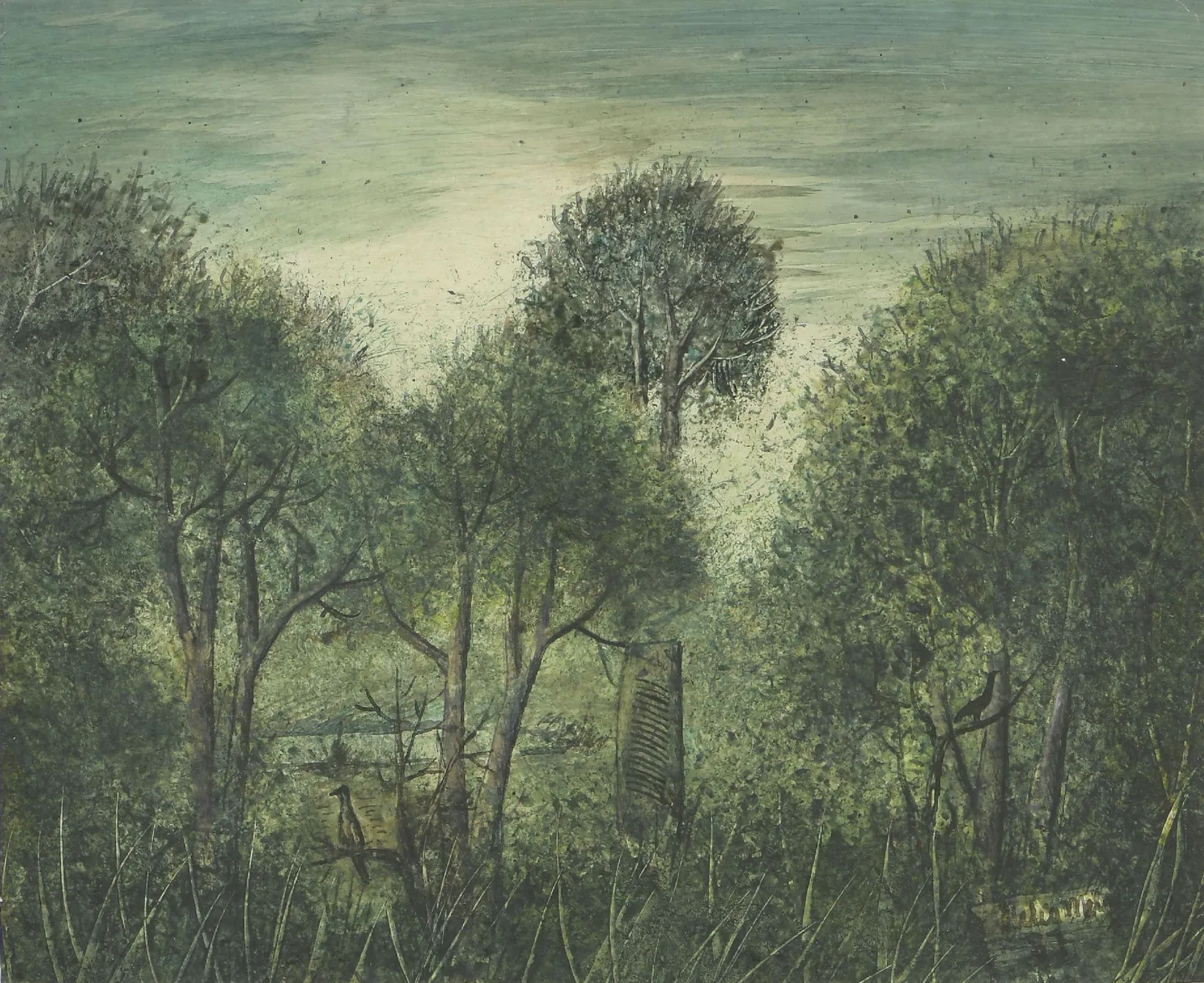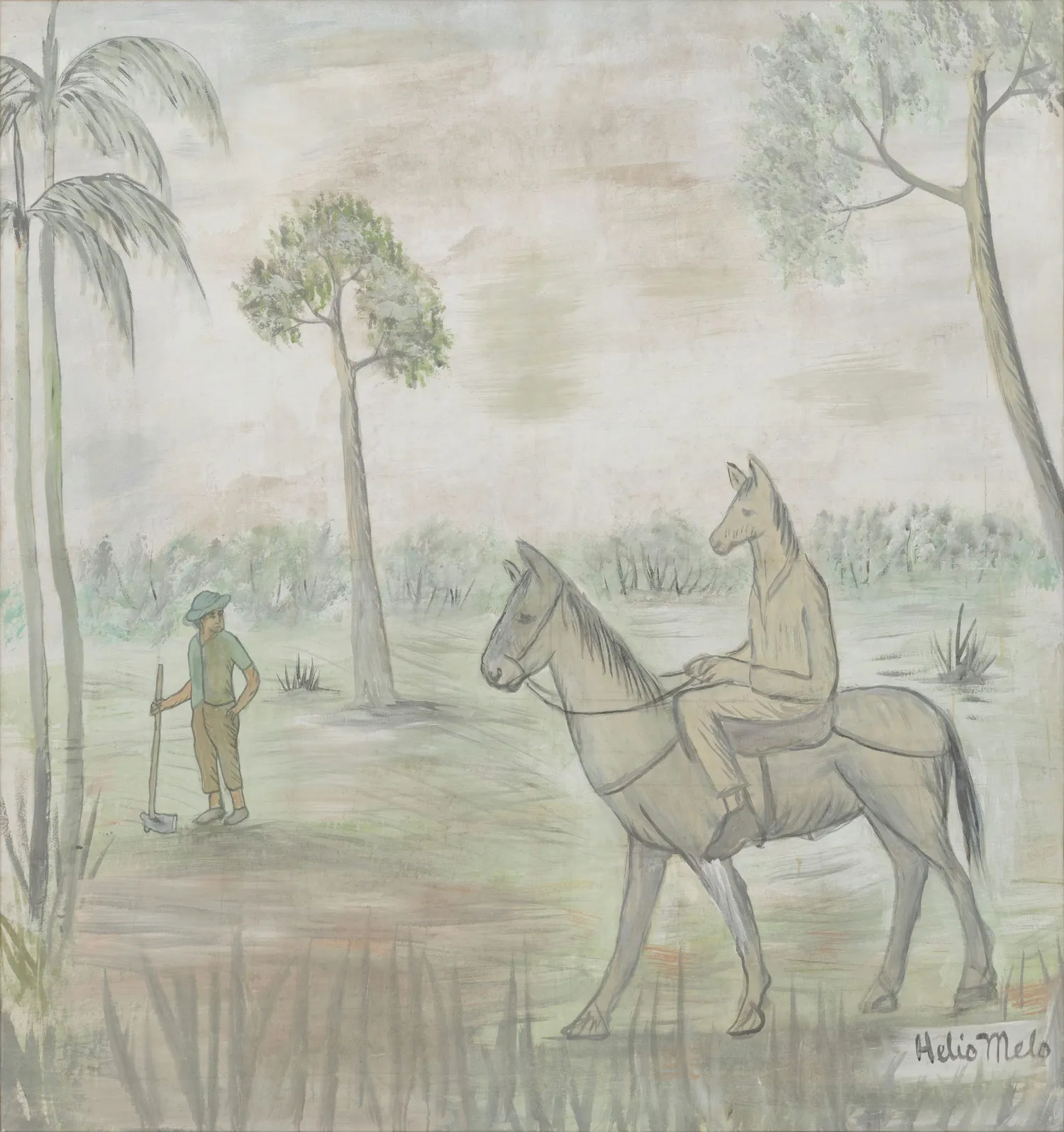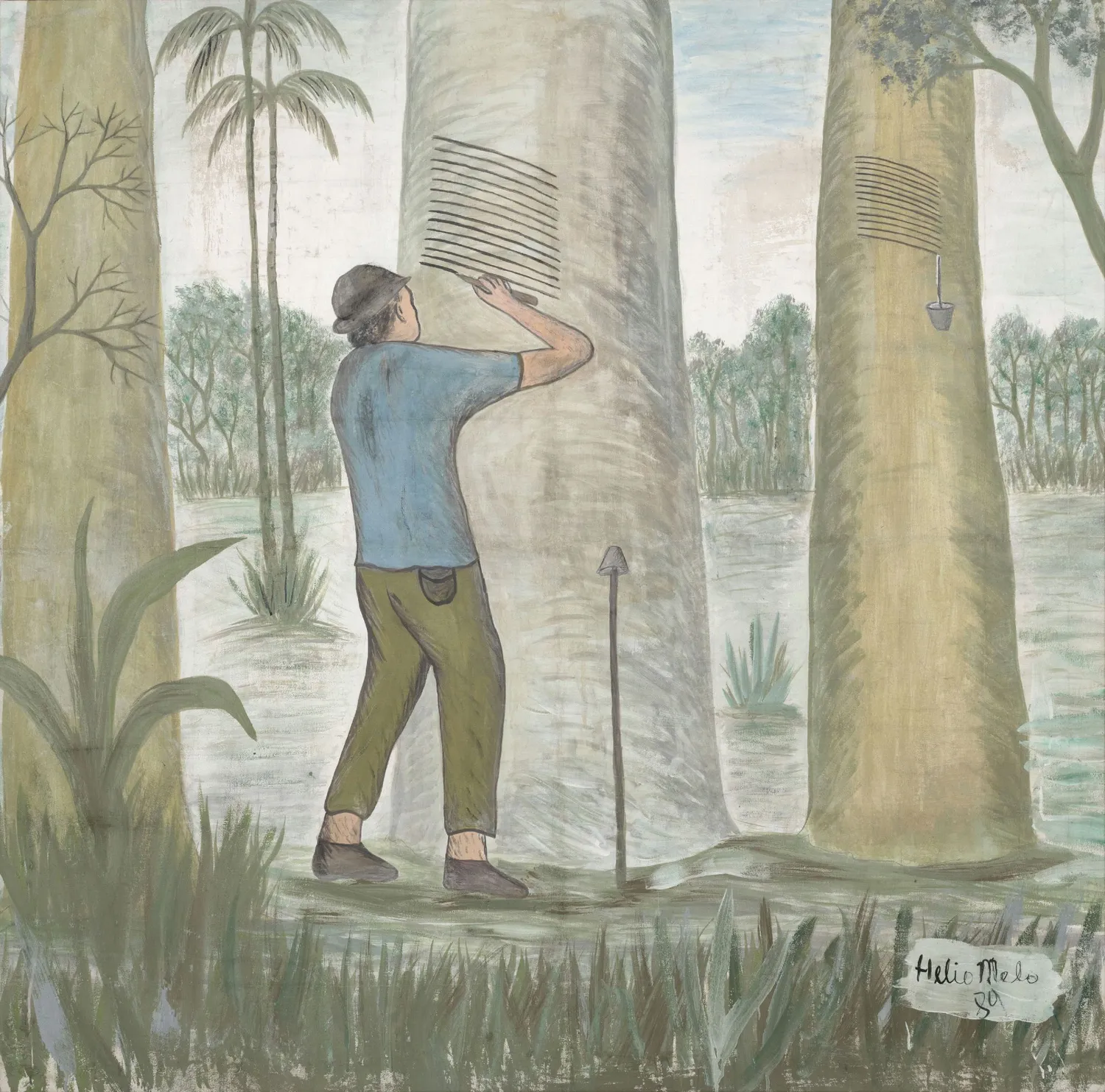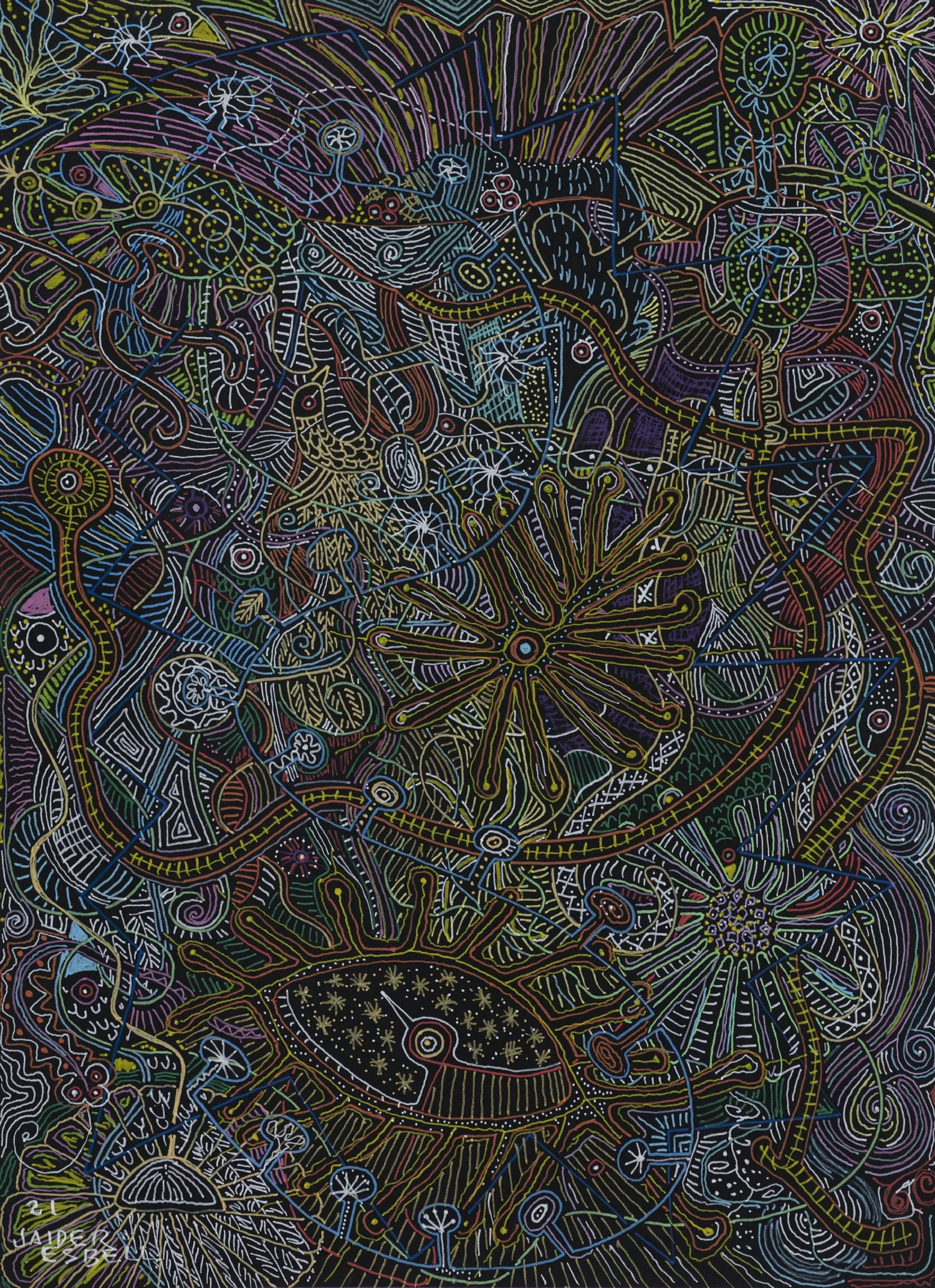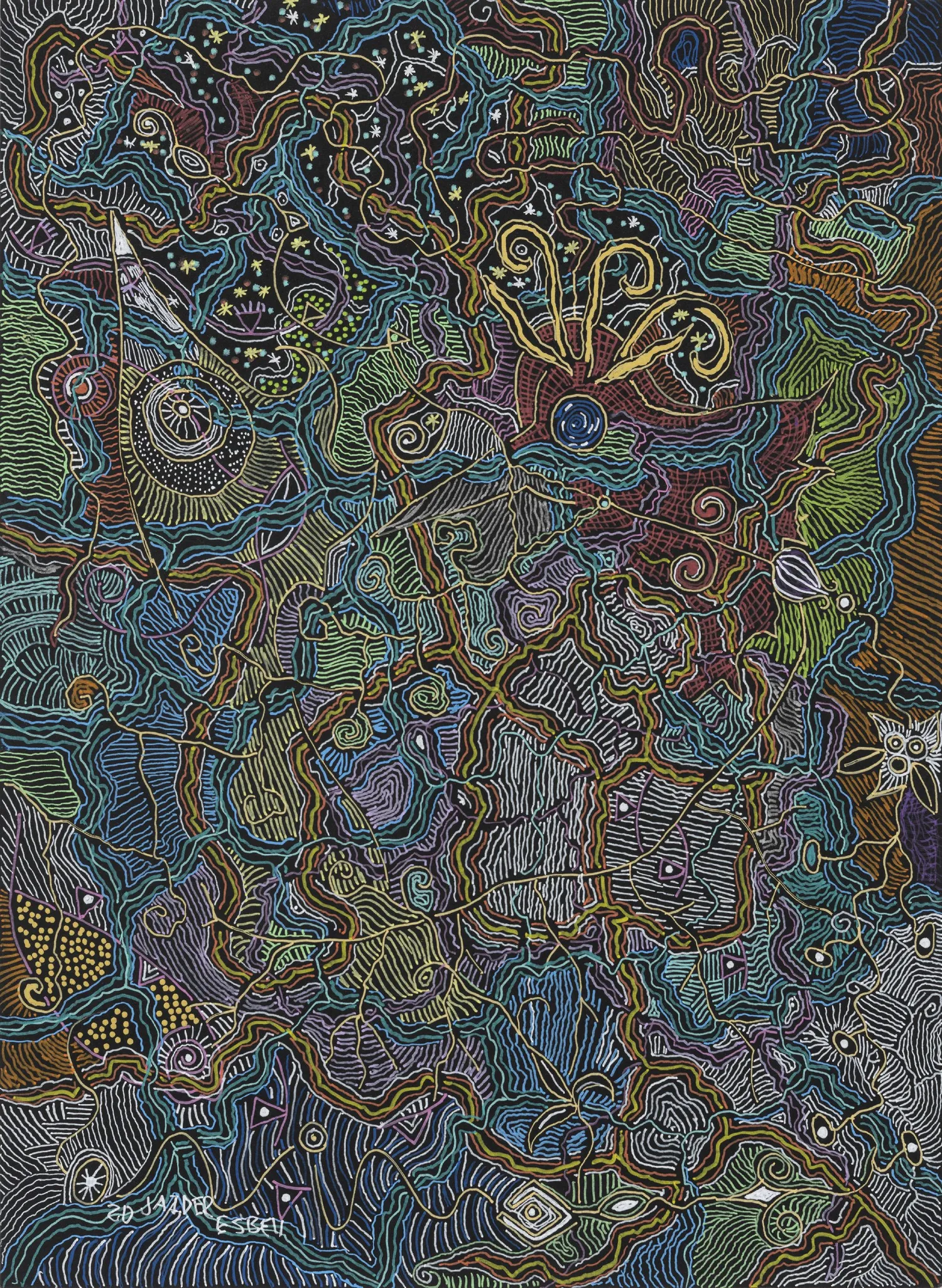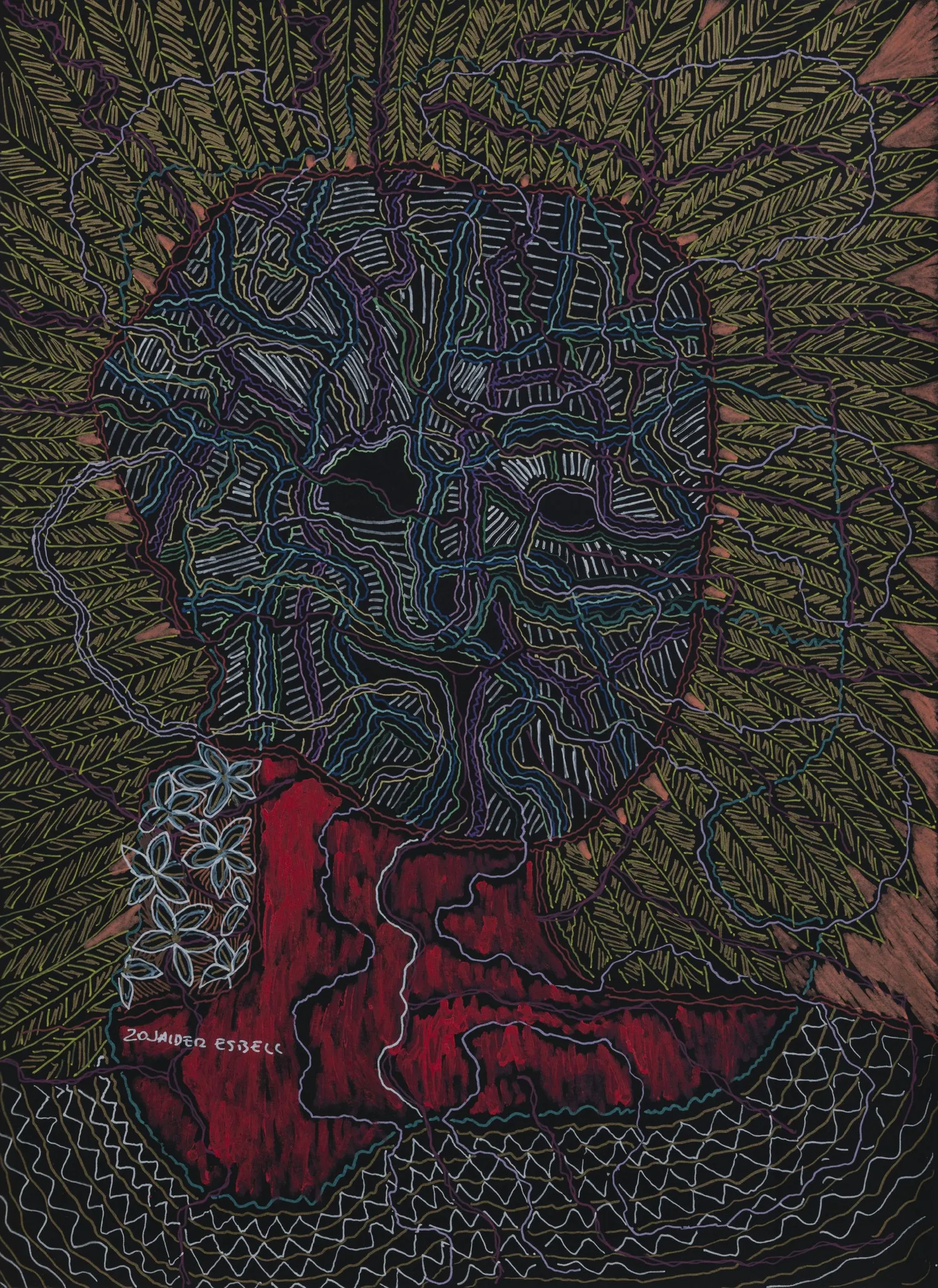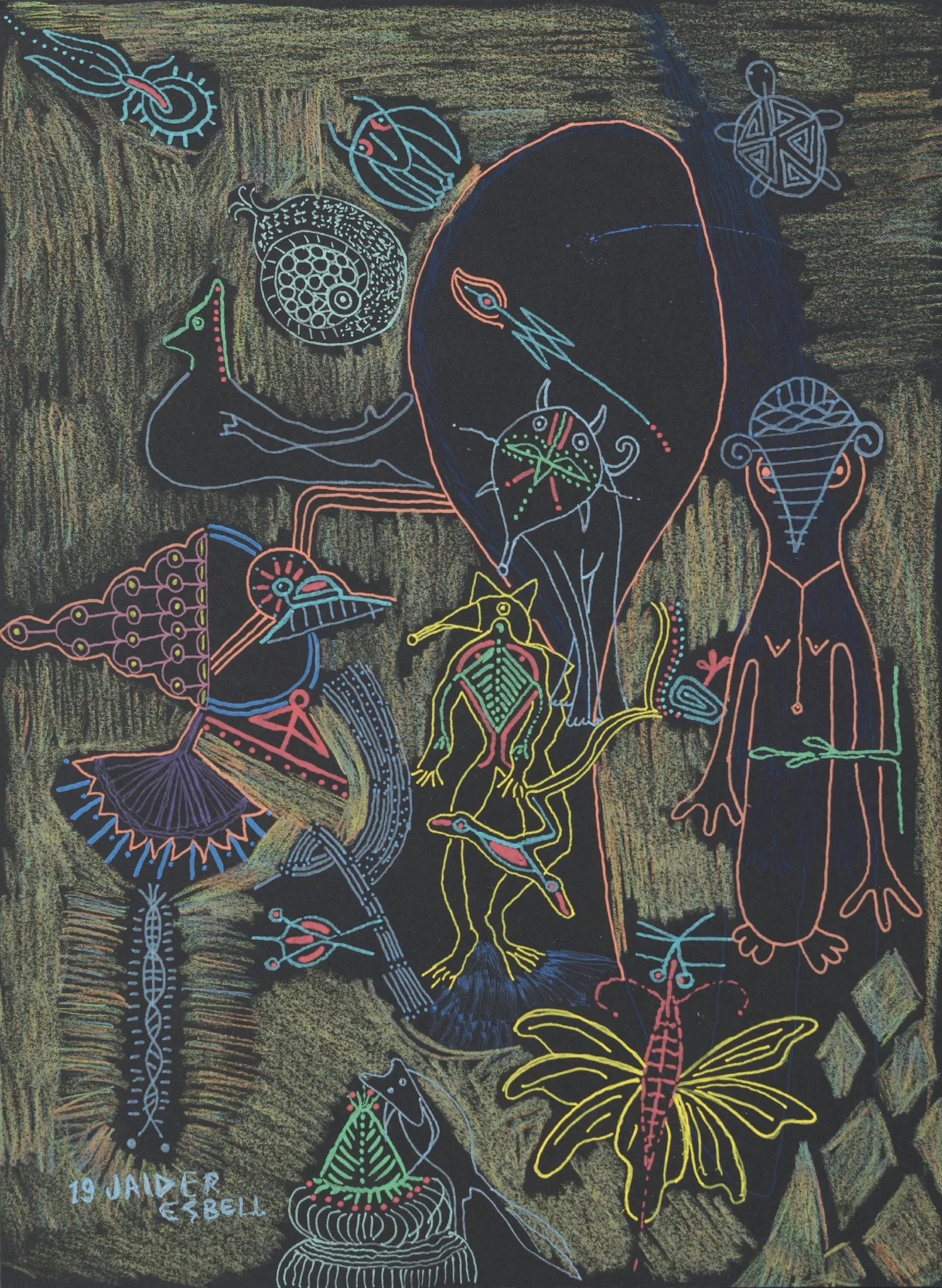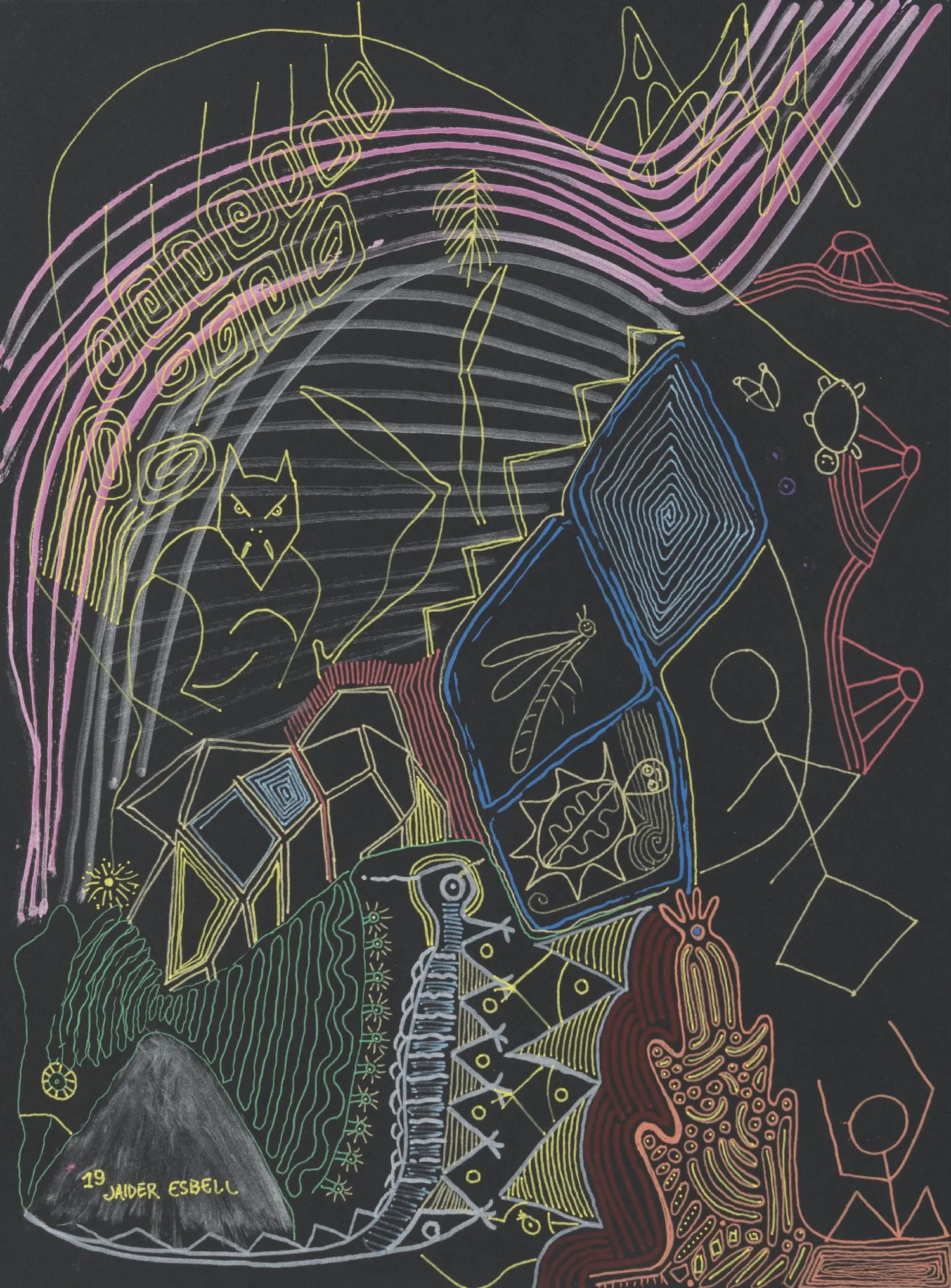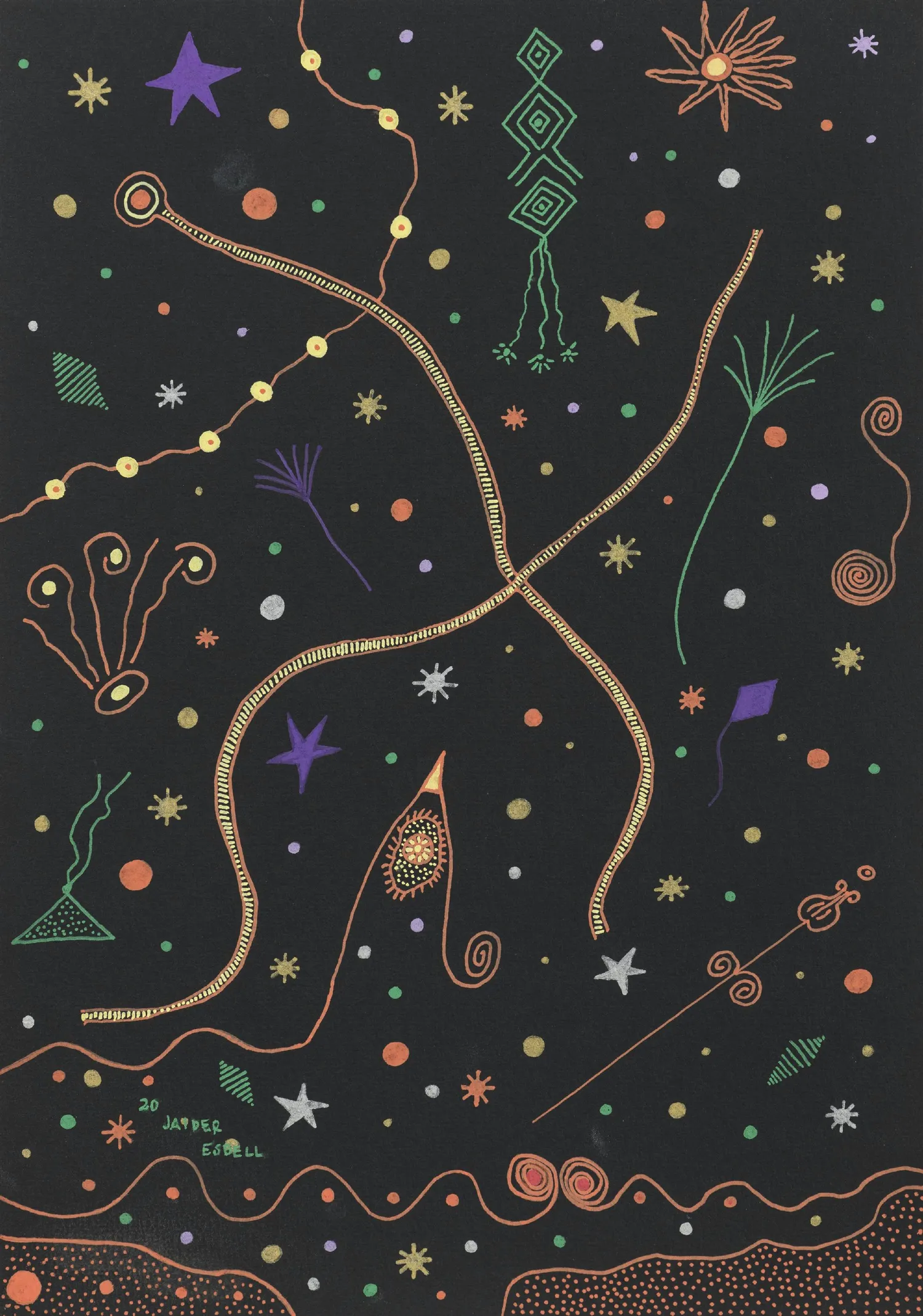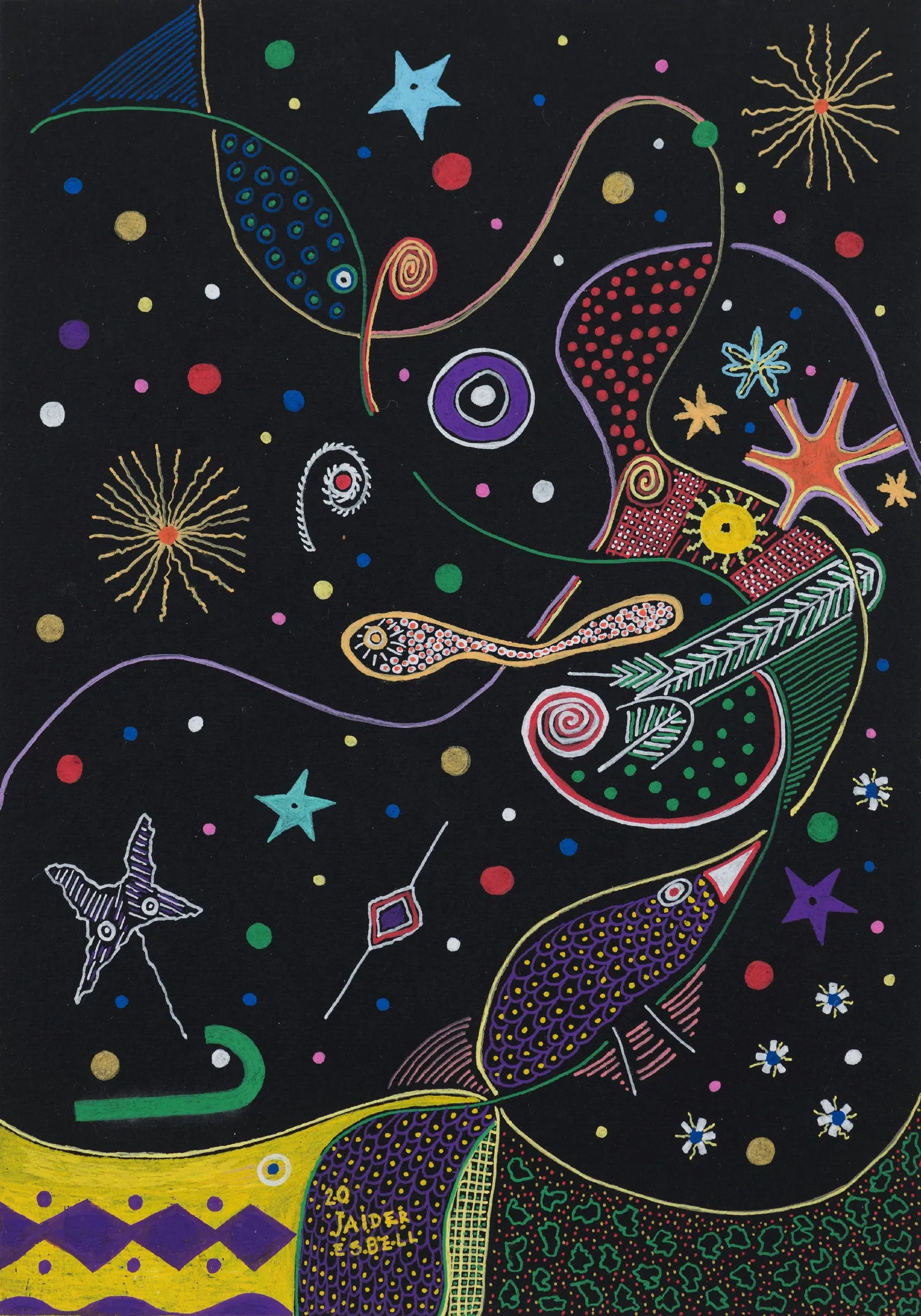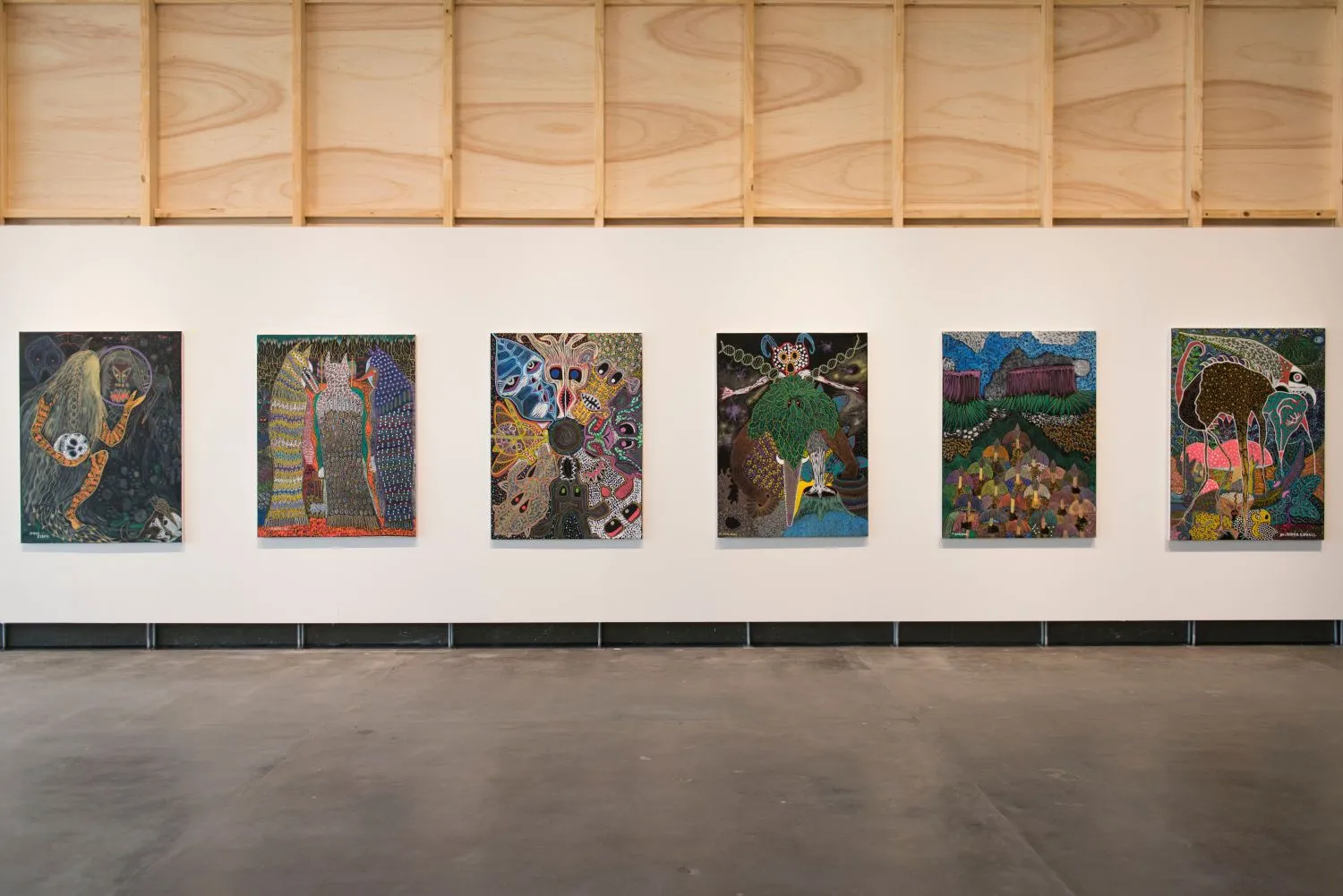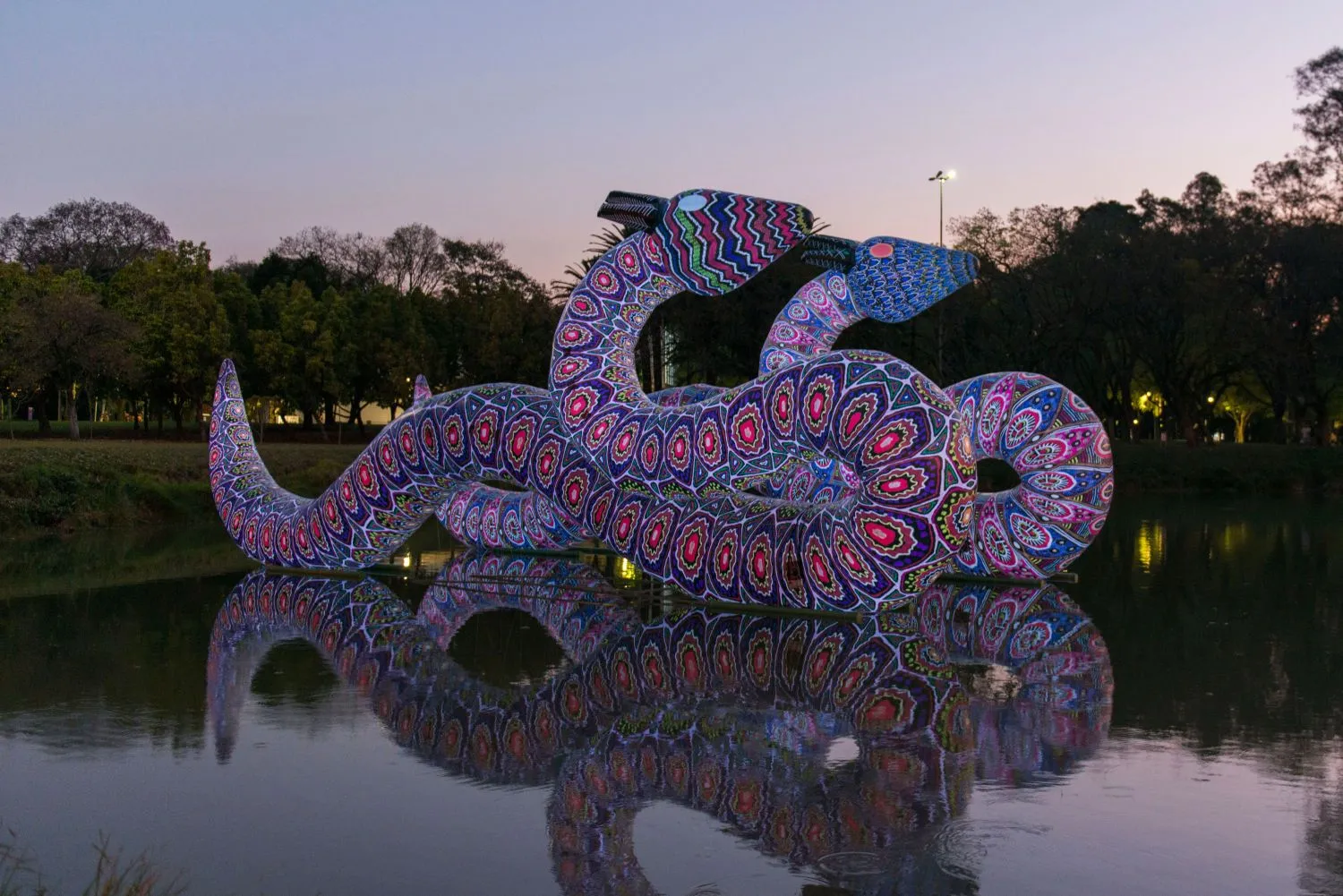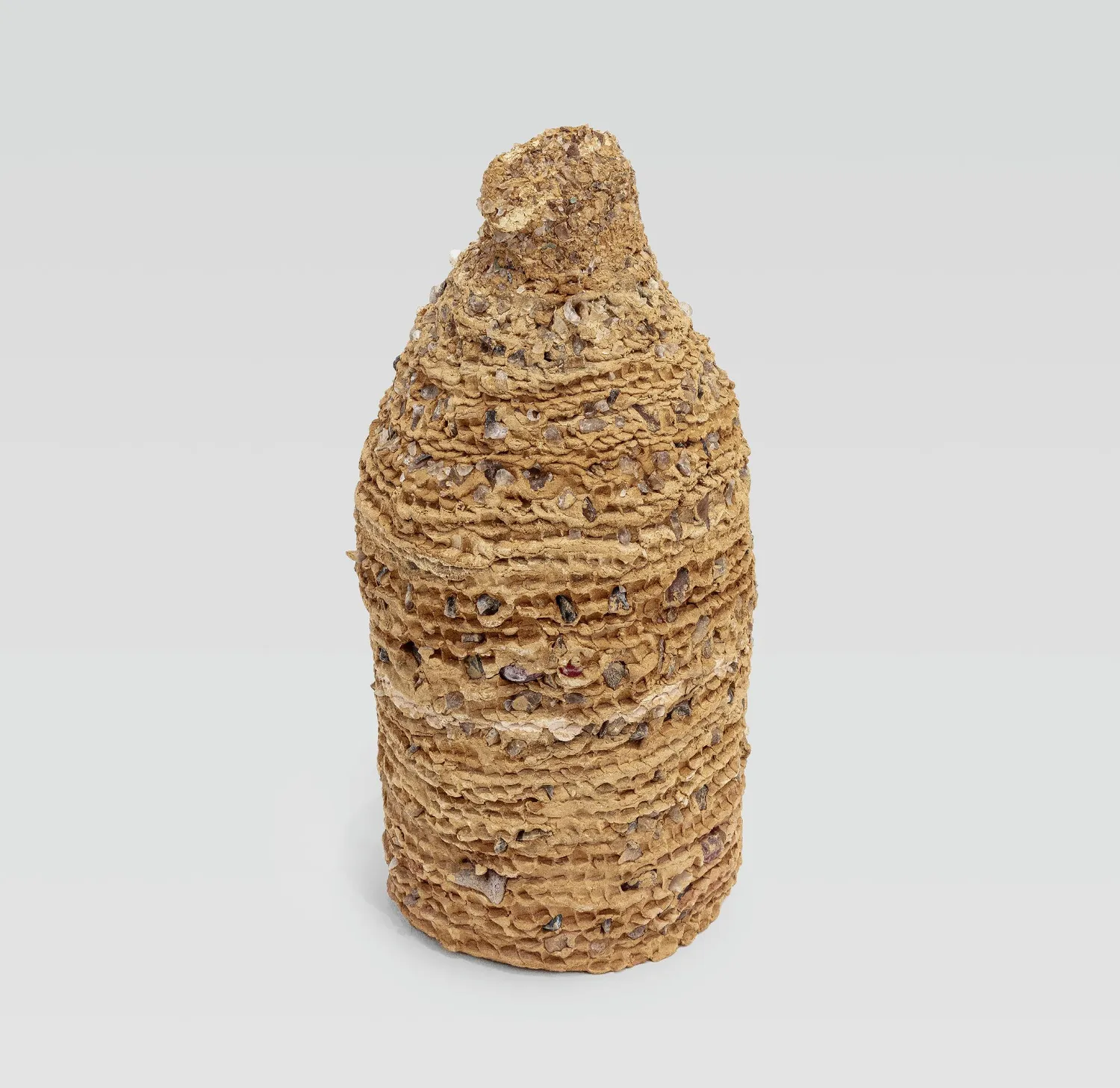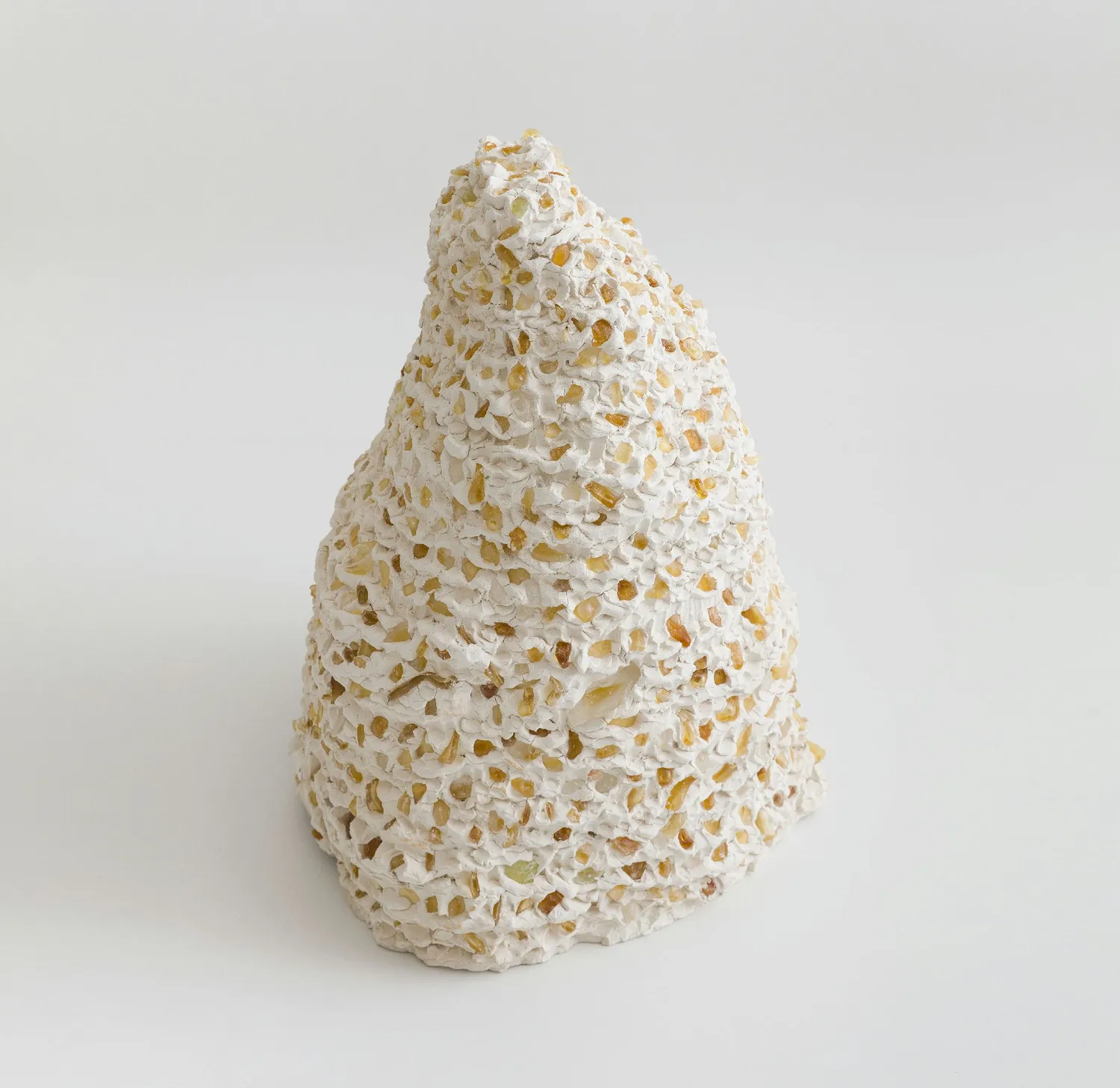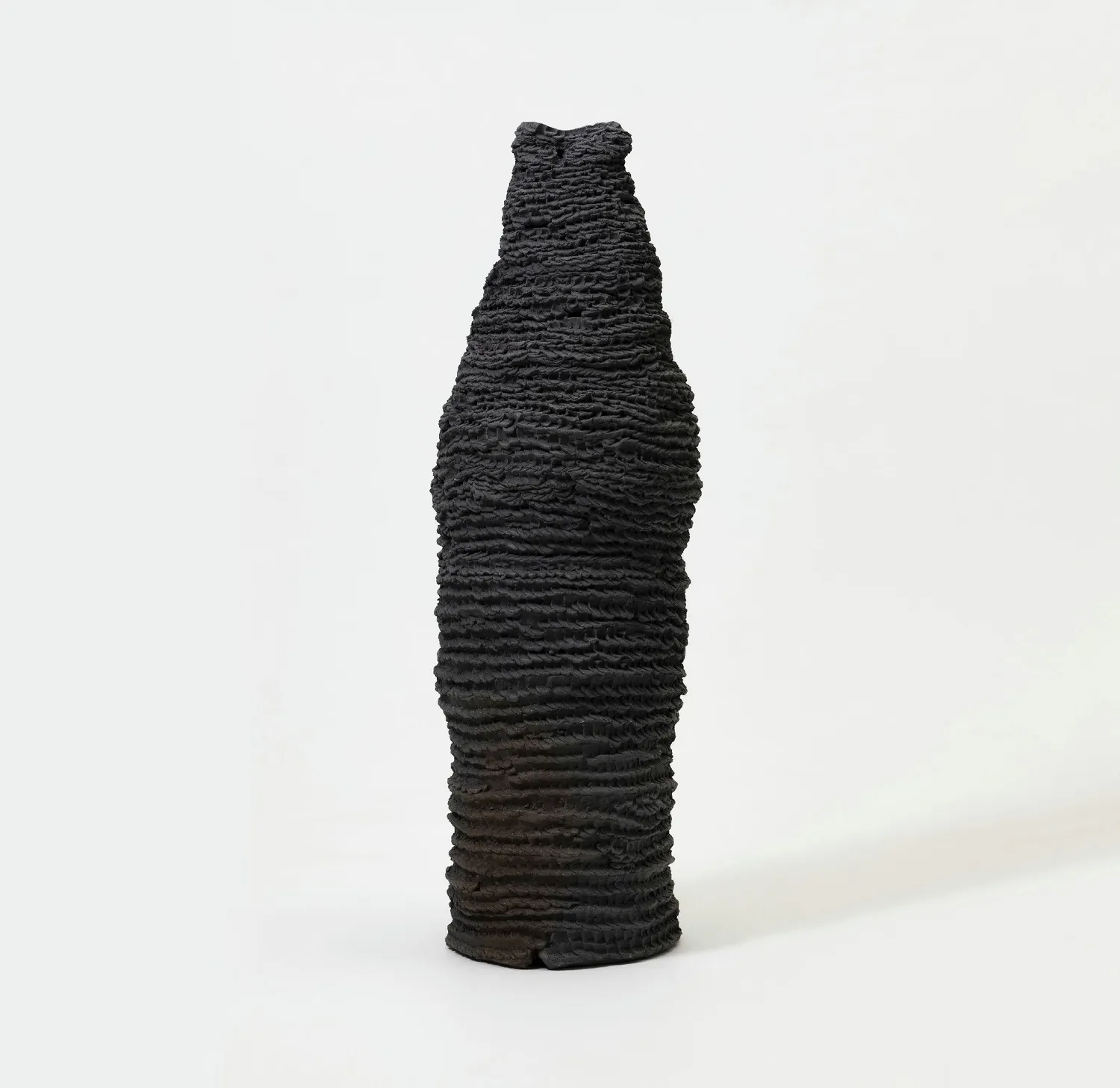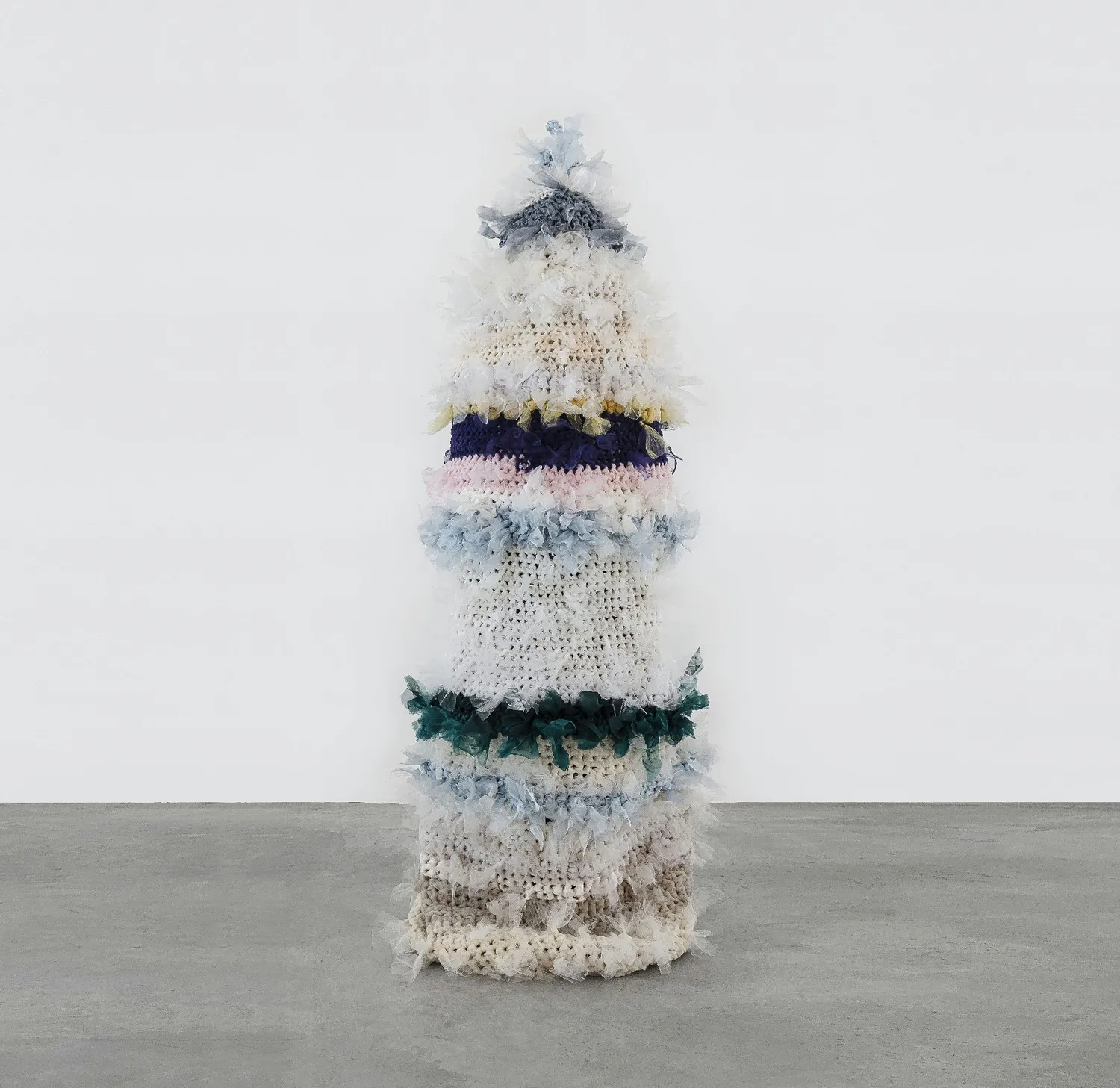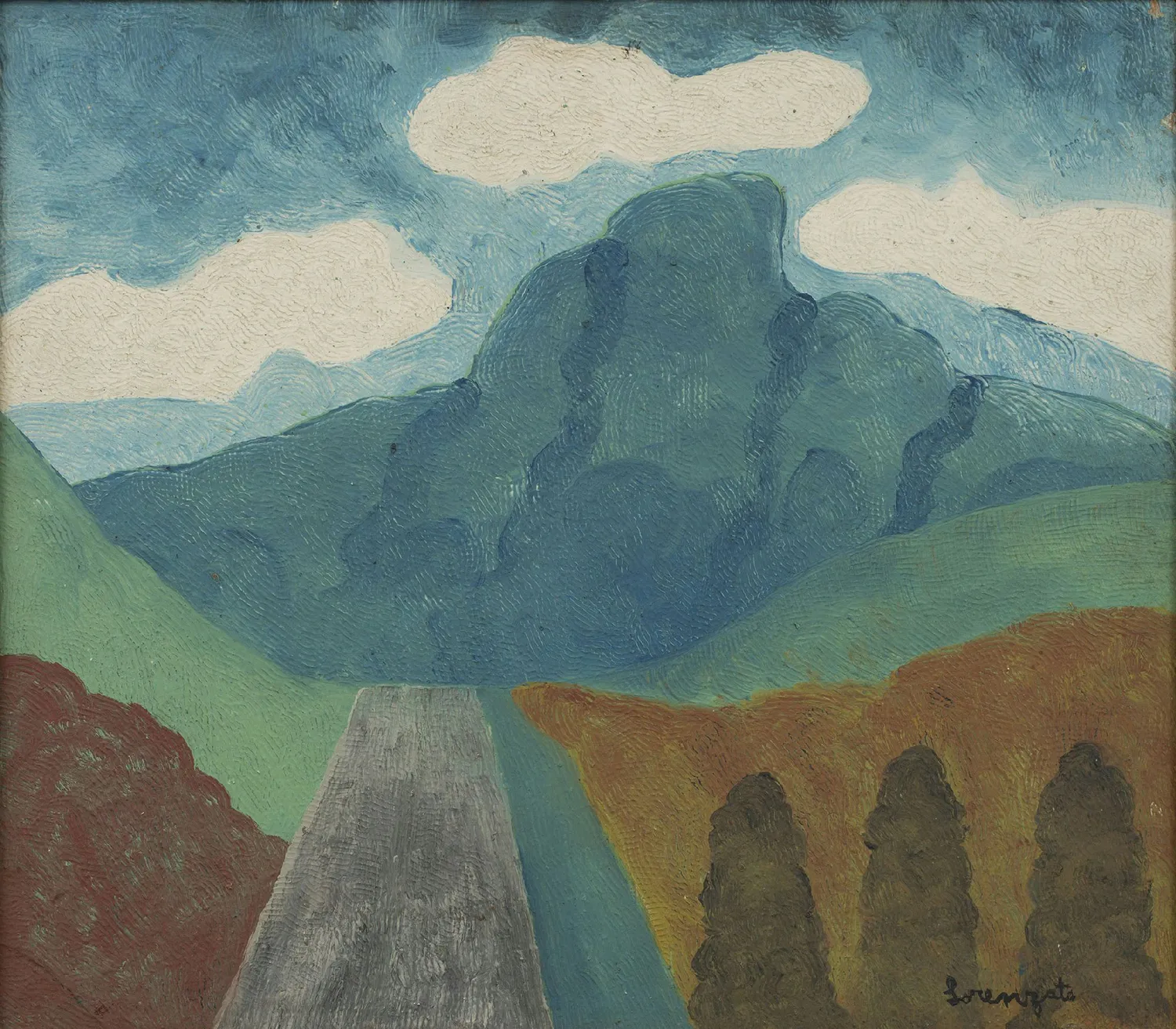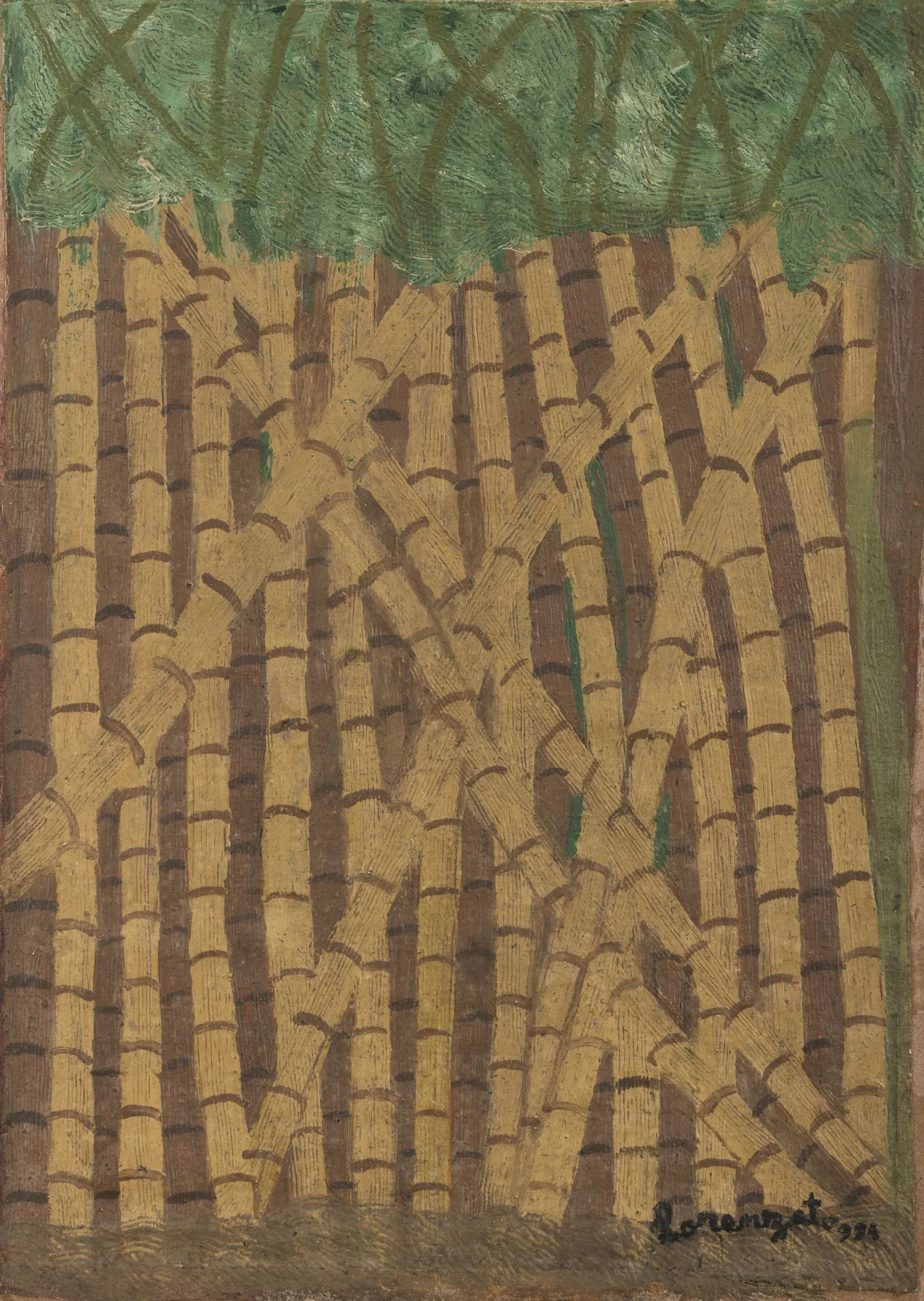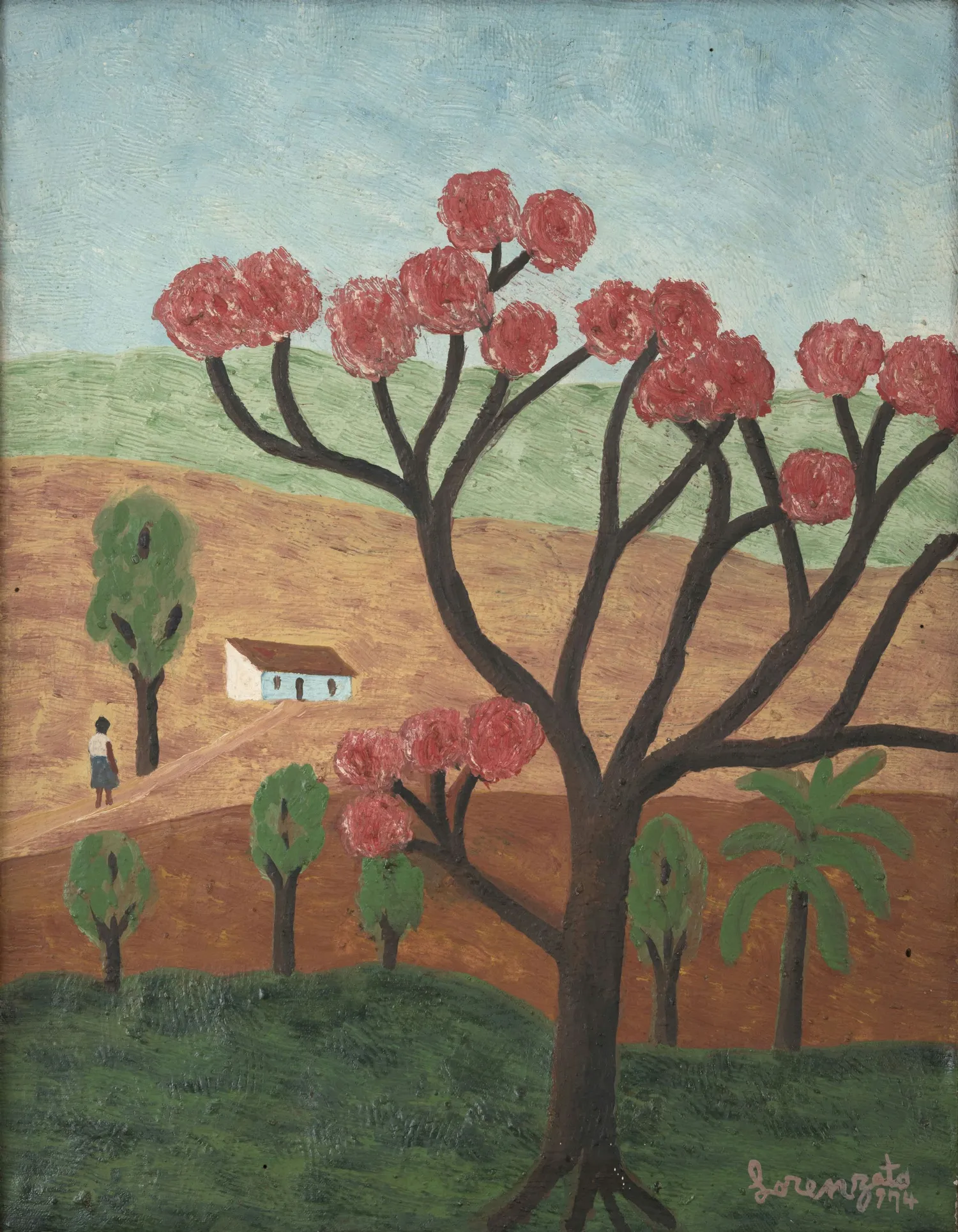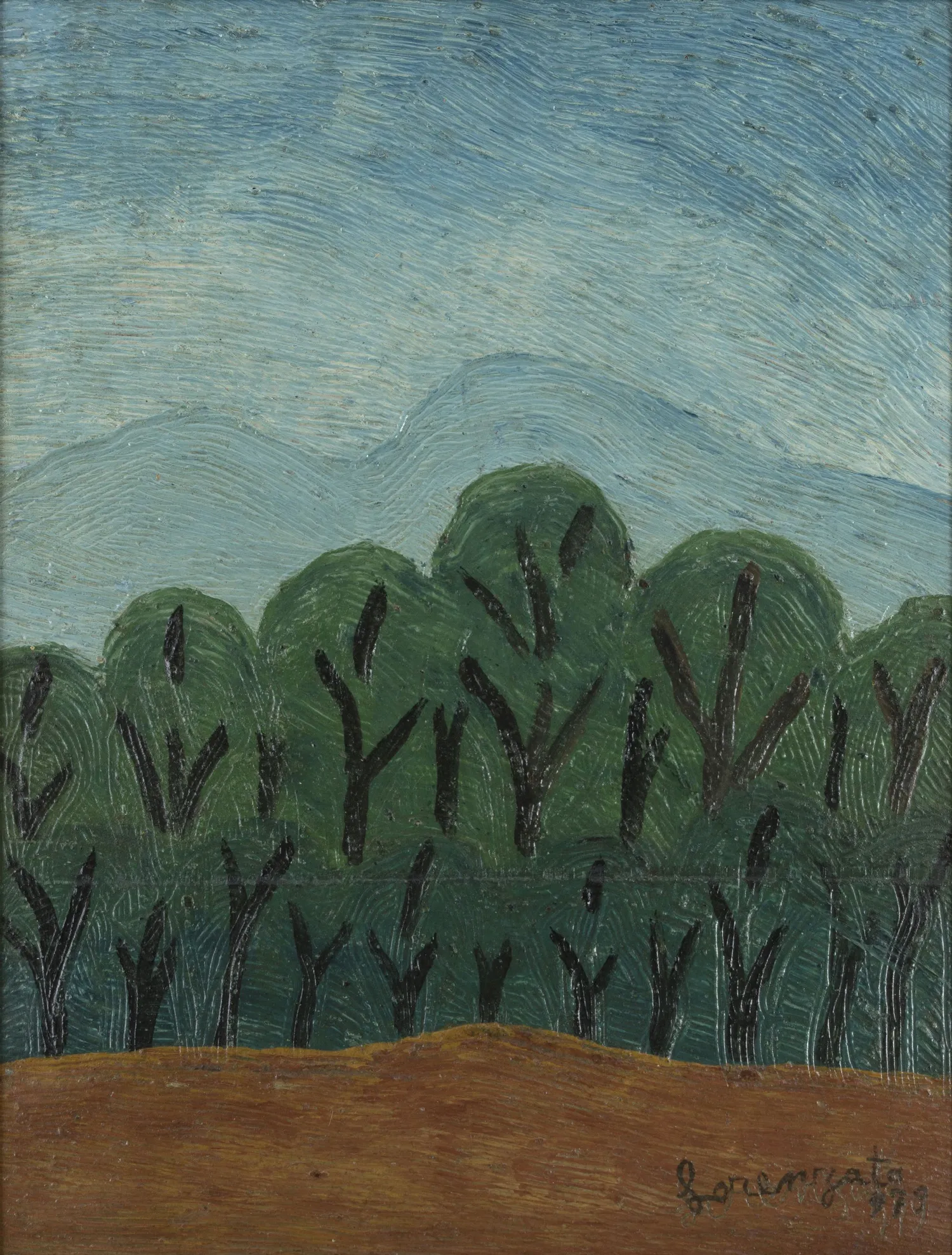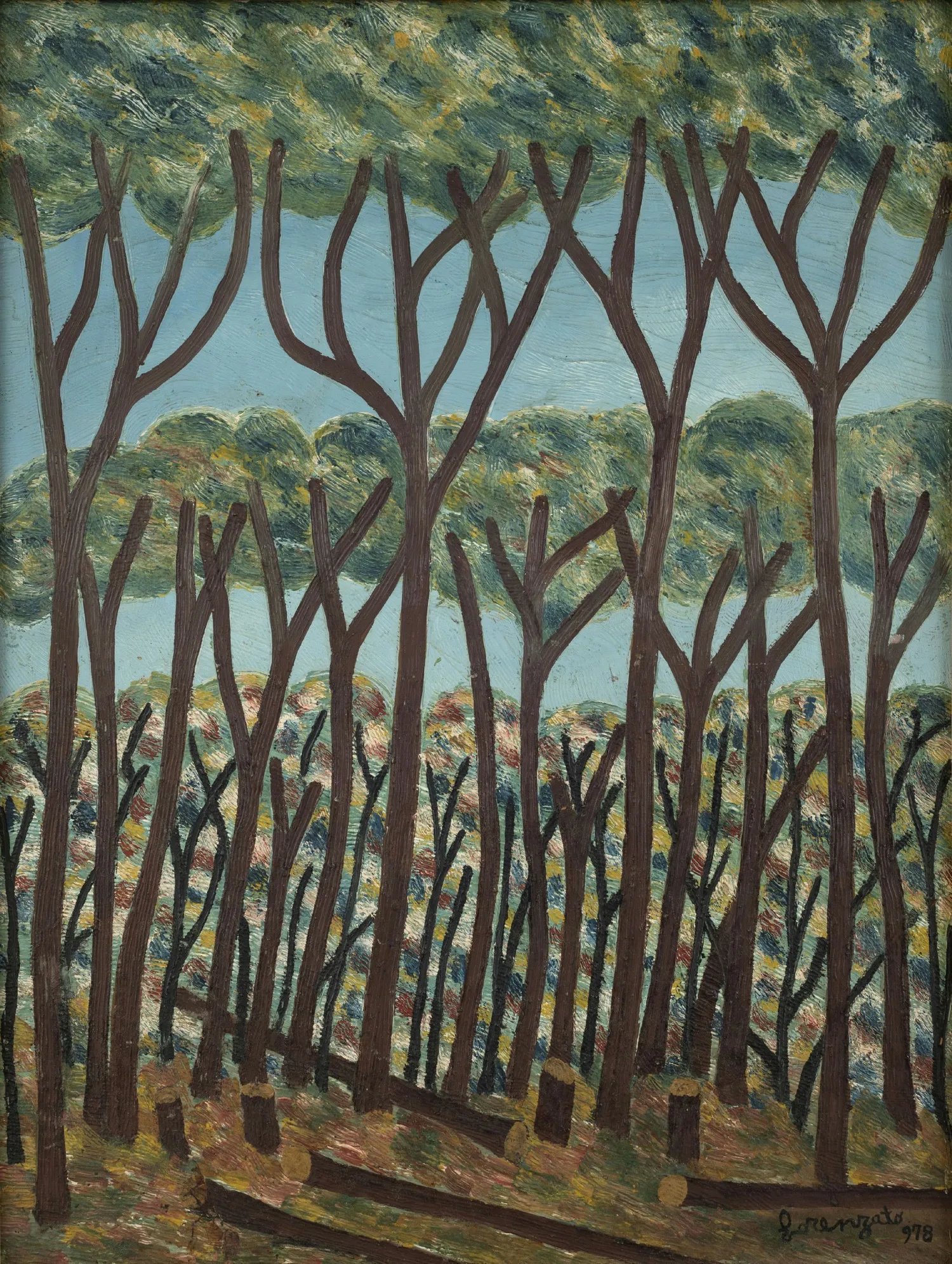Almeida & Dale features works by Lorenzato, Hélio Melo, Gustavo Caboco, Ivan Campos, Jaider Esbell, and Lidia Lisbôa—artists drawing attention to the relationship with the natural world through the representation of landscape, mythological narratives, or cosmologies. With their approaches, these artists shed light on human action towards nature through time and in different regions of Brazil.
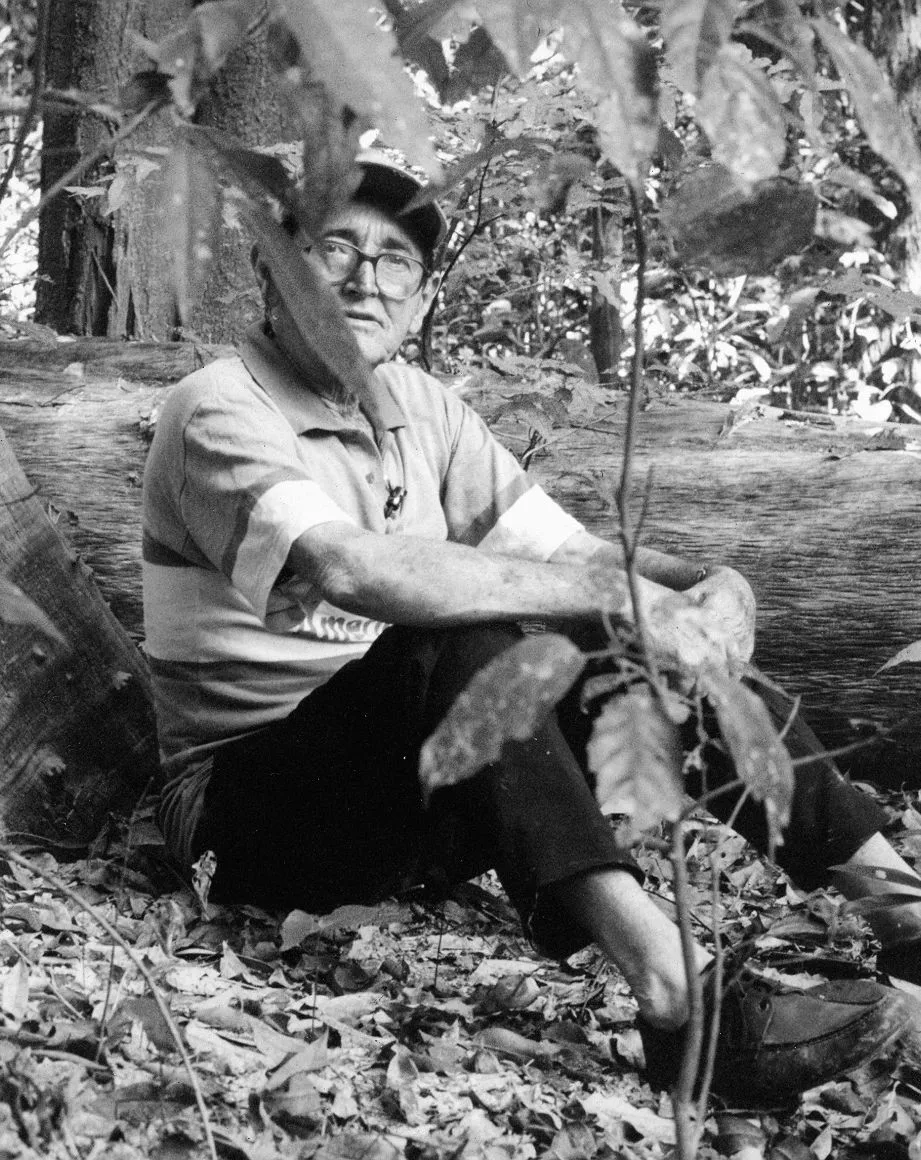
Hélio Melo
b. 1926, Vila Antimari/Boca do Acre, Brazil
d. 2001, Goiânia, Brazil
Hélio Melo’s work centers around the portrayal of life experiences shared by rubber tappers. The universe of the Amazon forest plays a significant role in his paintings, which feature numerous encoded references to myths, historical characters and political conflicts within this territory.
Melo's paintings and drawings were featured in a special room in the 27th Bienal de São Paulo (Brazil, 2006). His work was also in the exhibition Brazilian Histories, at MASP (São Paulo, Brazil, 2022) and was subject of a solo at Almeida & Dale (São Paulo, Brazil, 2023). Additionally, Melo is featured in permanent collections, such as the Centre Pompidou, Pinacoteca de São Paulo, and MASP.

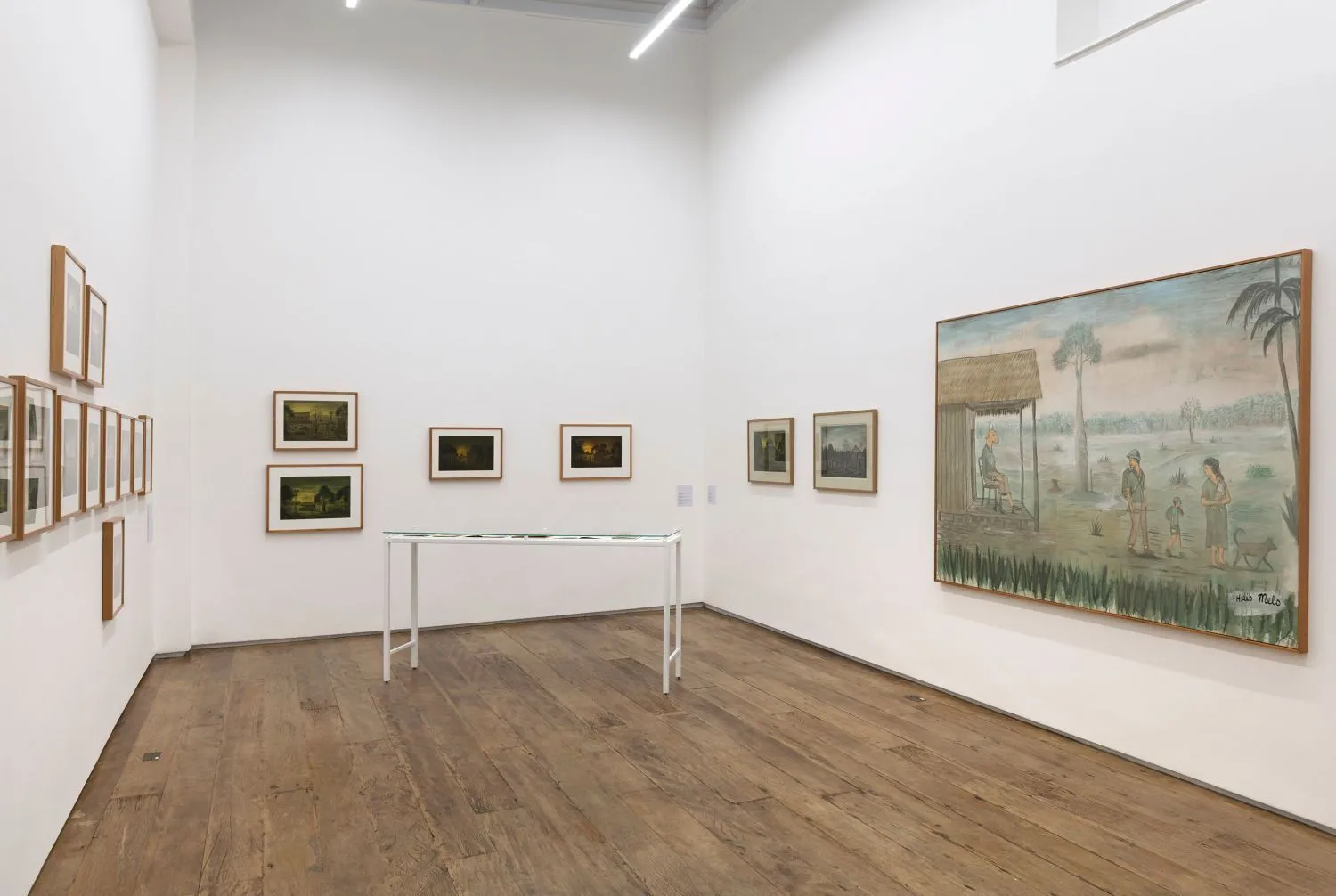
Hélio Melo, Almeida & Dale, São Paulo, Brazil, 2023
[…] the forest painted by Melo is an organism that feeds and is fed, which manifests many forms of violence and destruction, which cries with the animals, which feels, suffers and talks in its own way. The forest is, therefore, not only thinking but also sentient, a living and reactive universe in which everything is closely linked.
—Jacopo Crivelli Visconti
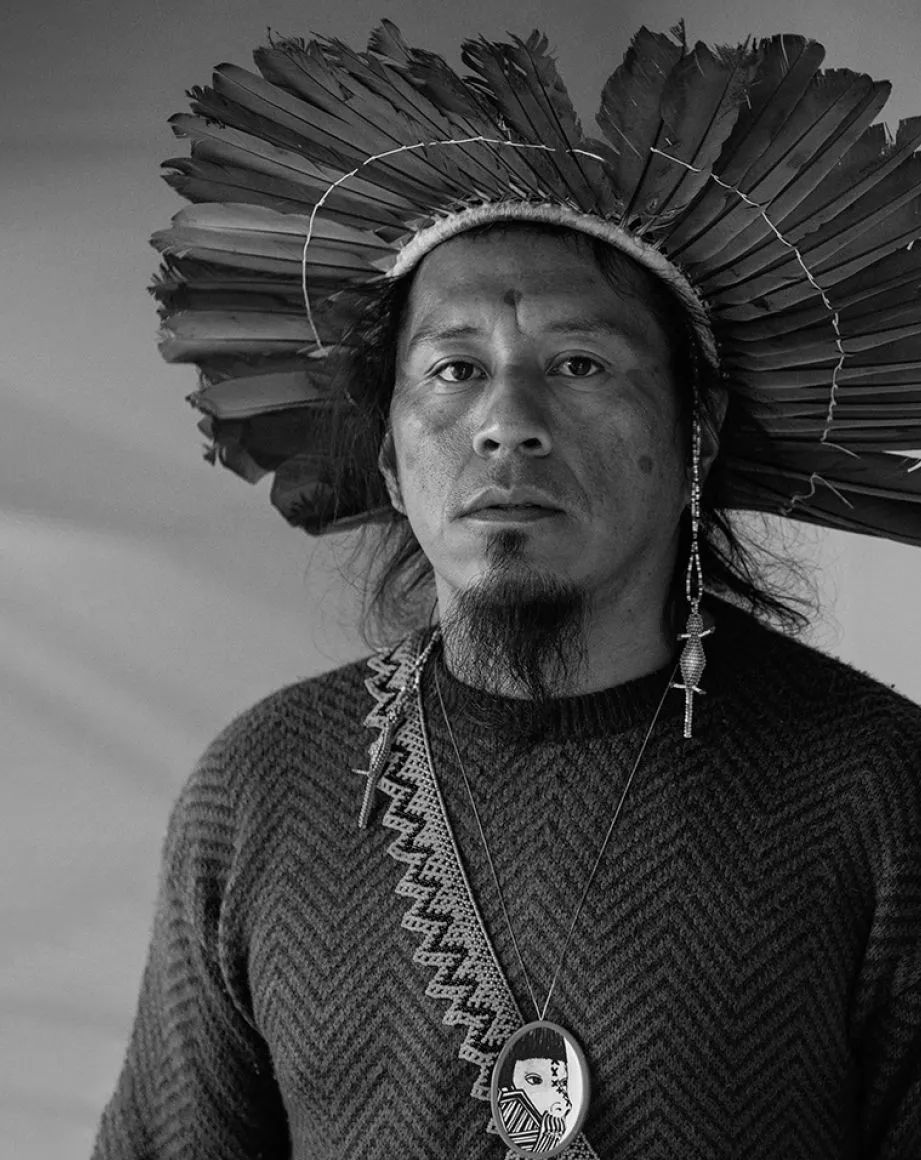
Jaider Esbell
b. 1987, Raposa Serra do Sol Indigenous Territory/Normandia, Brazil
d. 2021, São Sebastião, Brazil
Jaider Esbell combined artistic creation with the defense of Indigenous and land rights by exercising what he called Artivism. The vibrant colors that overlay the deep black backgrounds in his works shape visions of traditional narratives and spirits that populate the Macuxi worldview.
Currently, Gladstone Gallery is holding the first show dedicated to Esbell's work in the US. His legacy has been consolidated through exhibitions such as the 59th Venice Biennale (Italy, 2022); the 34th Bienal de São Paulo (Brazil, 2021); Siamo Foresta at the Triennale Milano (Italy, 2023); Les Vivants and Le Serpent Cosmique (Lille, France, 2022), organized by the Fondation Cartier pour l'art contemporain. His work is part of the collections of the Centre Pompidou, Fondation Cartier pour l’art contemporain, Museo de Arte Latinoamericano de Buenos Aires-MALBA and Pinacoteca de São Paulo.

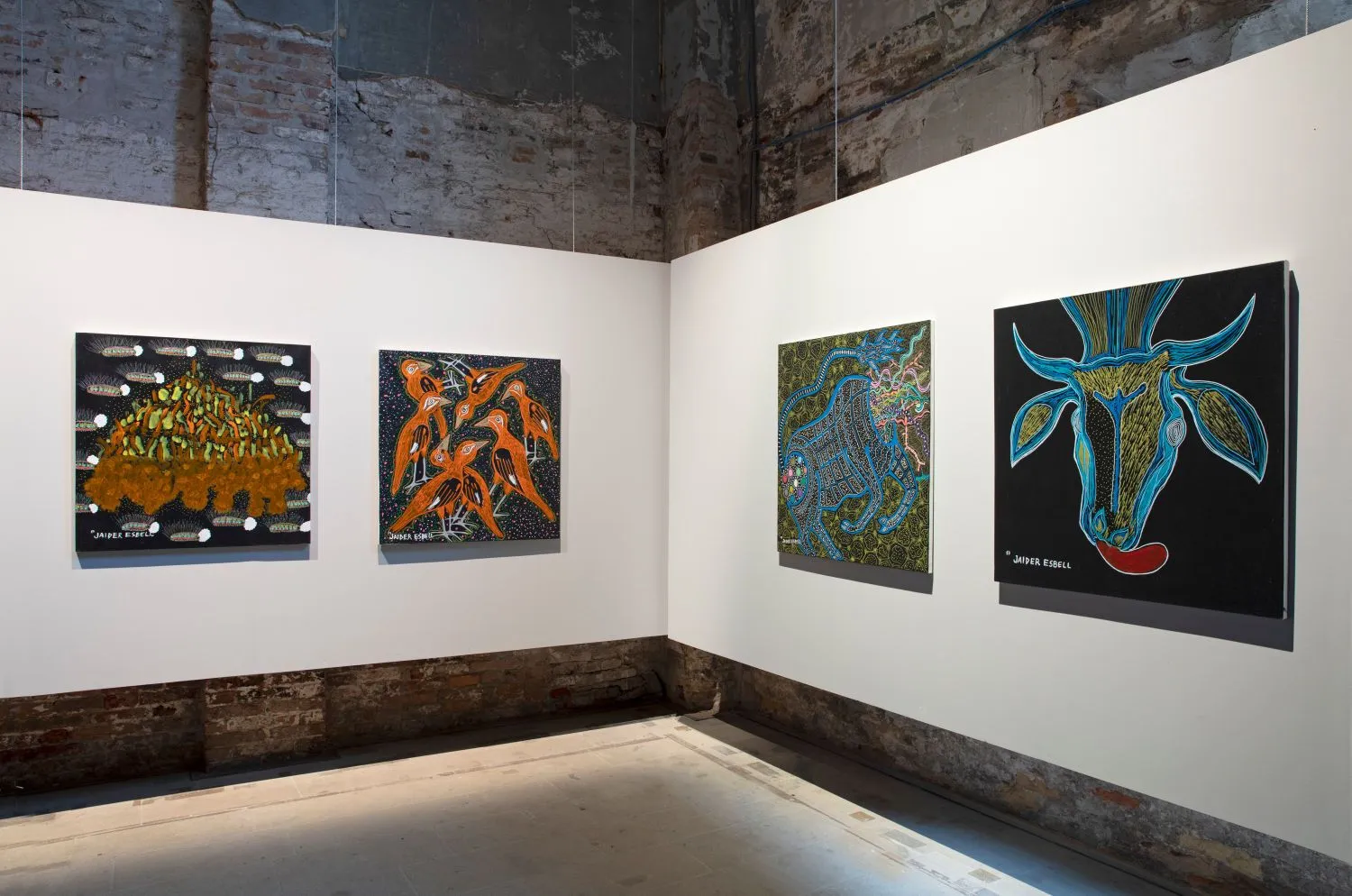
59th Biennale di Venezia — The Milk of Dreams, Venice, Italy, 2022
The energy of colors nourishes my soul. My soul is filled with color, since that is how my ancestral grandfather, Makunaimî, shows it to me. Our lineage is based on transformation. Therefore, colors are, as is the sound of our music, our platform for existence and for allowing for existence. We have faced total darkness, in other times, and it was the fragments of light that guided us on that journey. When we survived that darkness, the colors that kept us alive expanded wildly. We don’t know how to live in a world that is pastel, or grey, or black or white. We prefer a world in color.
—Jaider Esbell
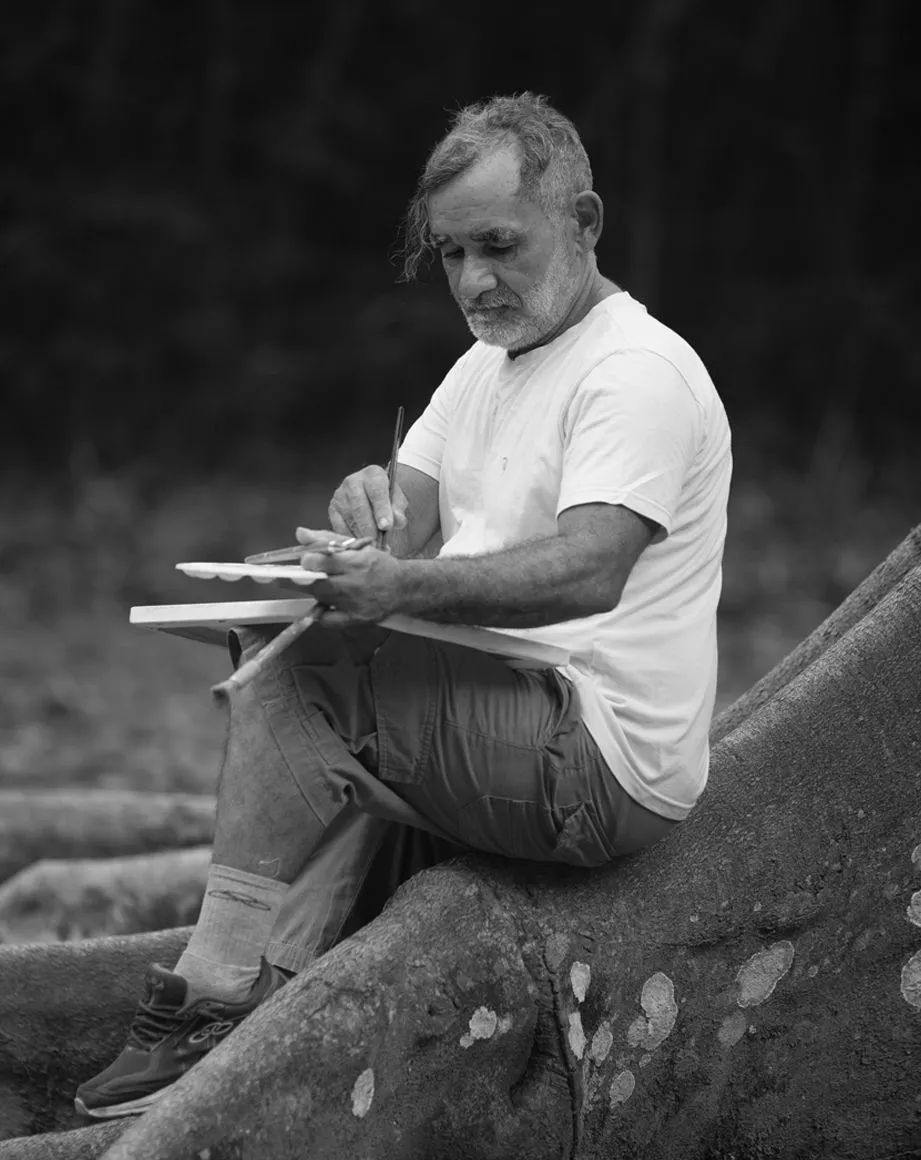
Ivan Campos
b. 1960, Rio Branco, Brazil
Lives and works in Rio Branco, Brazil
Ivan Campos draws inspiration from the Amazon, blending in his canvas real and imagined events within the forest. In his works, nature is represented through biological, marvelous, mystical, and ancestral dimensions.
Campos first began exhibiting his paintings in cities in the Amazon region in the 2000s. In 2005, he won a gold medal at the 1st Hélio Melo Fine Arts Salon (Rio Branco, Brazil). His works have recently garnered considerable attention and have been displayed in exhibitions such as the 38th Panorama de Arte Brasileira — Mil Graus (São Paulo, Brazil, 2024) and Fullgás (Rio de Janeiro, Brazil, 2024).

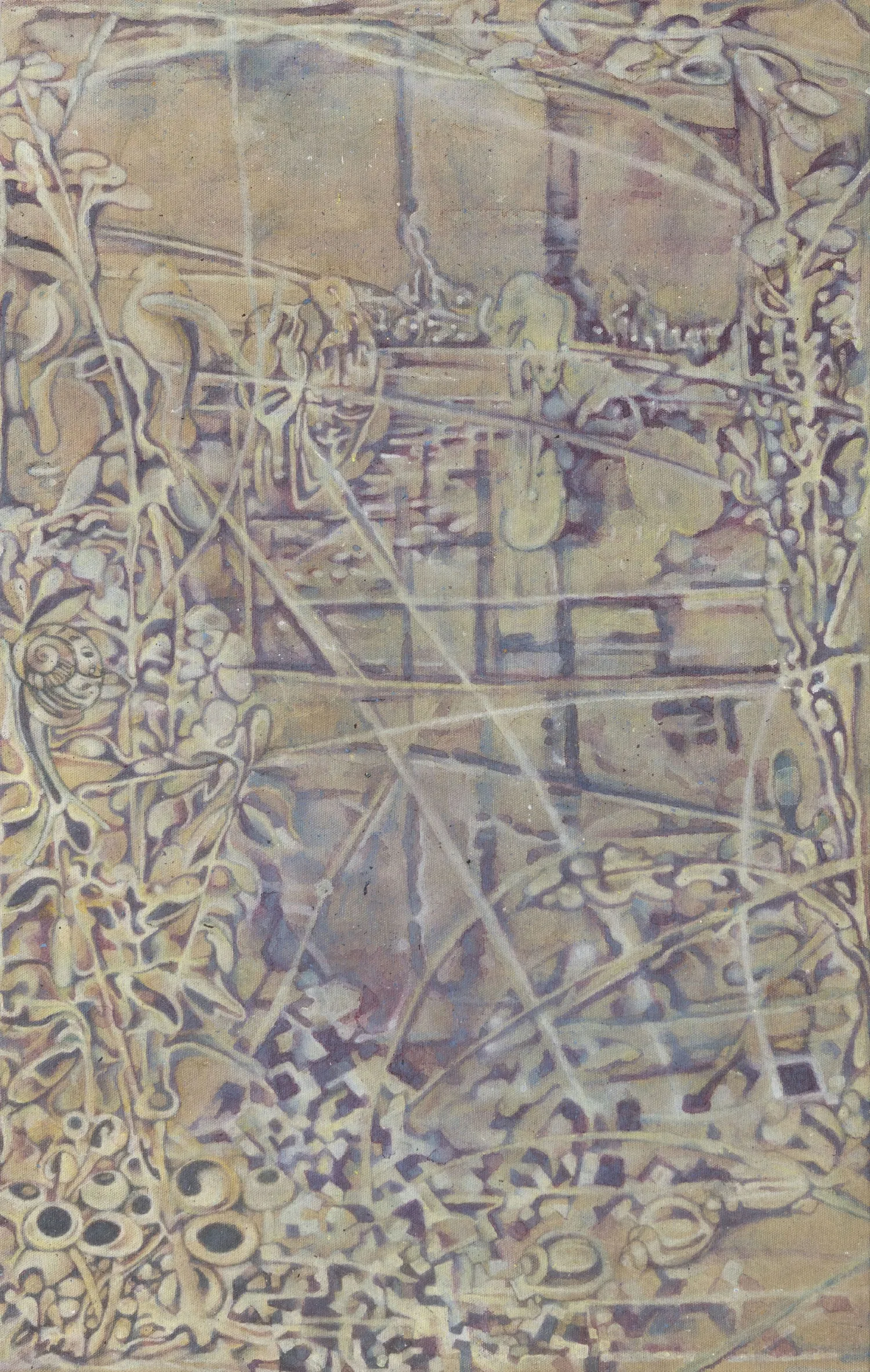
Untitled, 2023
Acrylic on canvas
67 x 41.5 cm [26 ½ x 16 ½ in]

Untitled, n.d.
Acrylic on fabric
42 x 86.5 cm [16 ½ x 34 in]
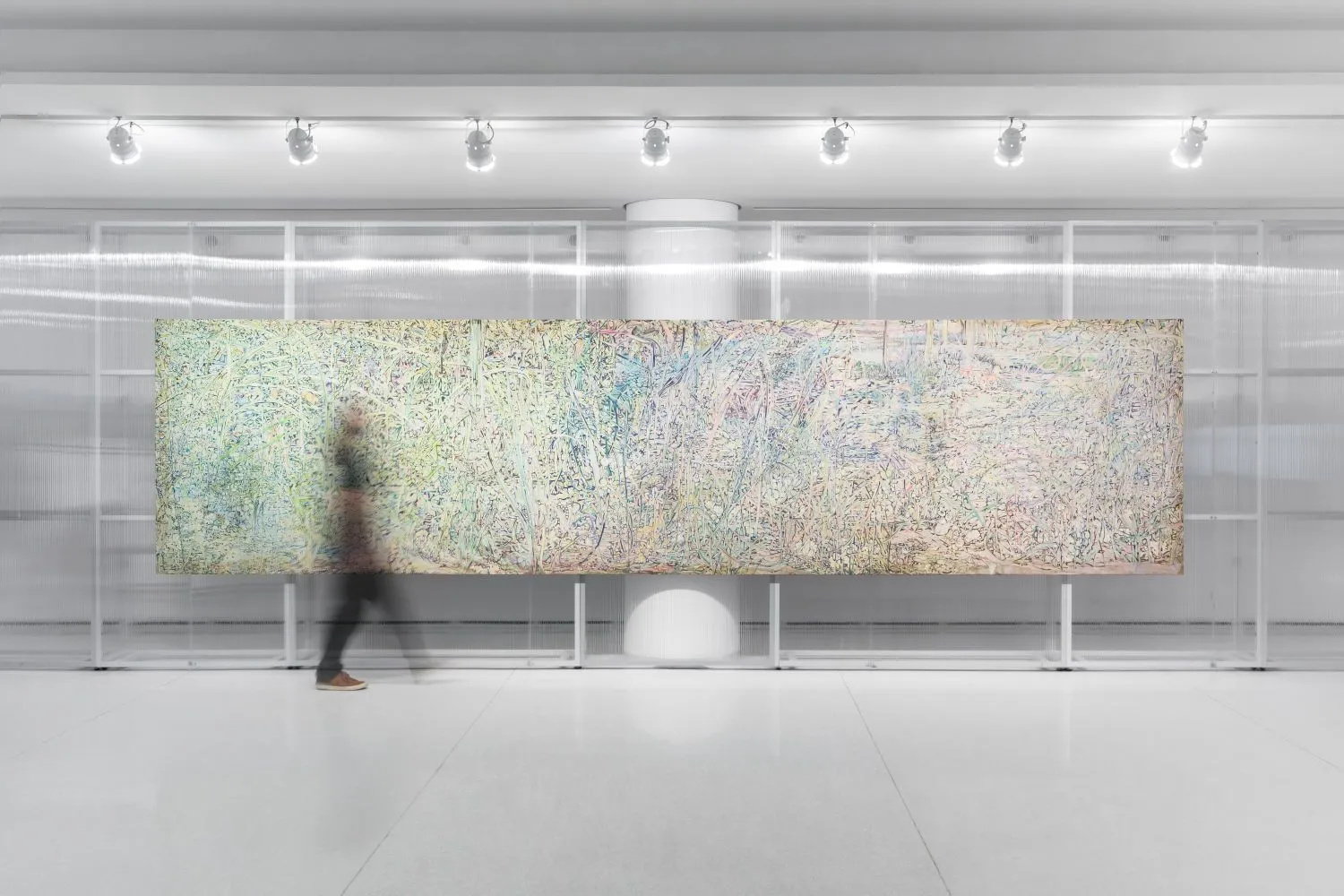
38th Panorama de Arte Brasileira — Mil Graus, MAC USP, São Paulo, Brazil, 2024
The universe of the forest is so infinite, there's no end to it. The things I see, an insect, a flower, a tree, even the different colors of water that the forest offers, that's what I paint about. I never tire of seeing the designs that the forest offers.
—Ivan Campos
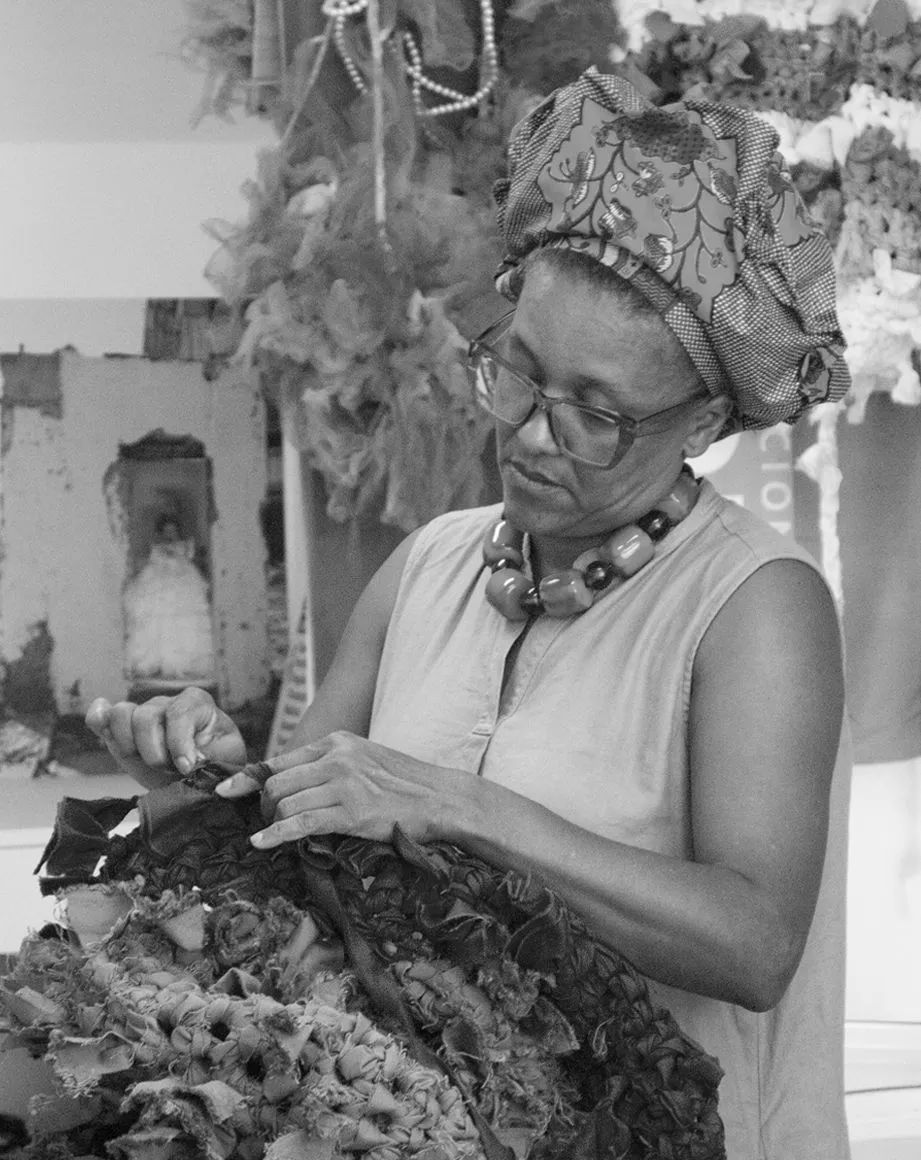
Lidia Lisbôa
b. 1970, Terra Roxa, Brasil
Lives and works in São Paulo, Brasil
Lidia Lisbôa's work is the result of a practice that constantly intertwines art and life, body and memory. Her practice is carried out in different mediums, mainly sculpture, crochet, performances, and drawings. The weaving of biographies is at the core of her research, covering the axis of landscape, the body, and memory by using materials on which the artist’s hand and gesture are imprinted.
Among her most recent exhibitions are "O Teatro" at Millan (São Paulo, Brazil, 2024), Têta at MAR (Rio de Janeiro, Brazil, 2024), and Mulher Esqueleto at Sesc Pompeia (São Paulo, Brazil, 2023). Other projects include group exhibitions at ISLAA (New York, USA, 2024) and Museo Madre (Naples, Italy, 2024), as well as the 37th Panorama da Arte Brasileira (São Paulo, Brazil, 2022) and the 13th Mercosur Biennial (Porto Alegre, Brazil, 2022).

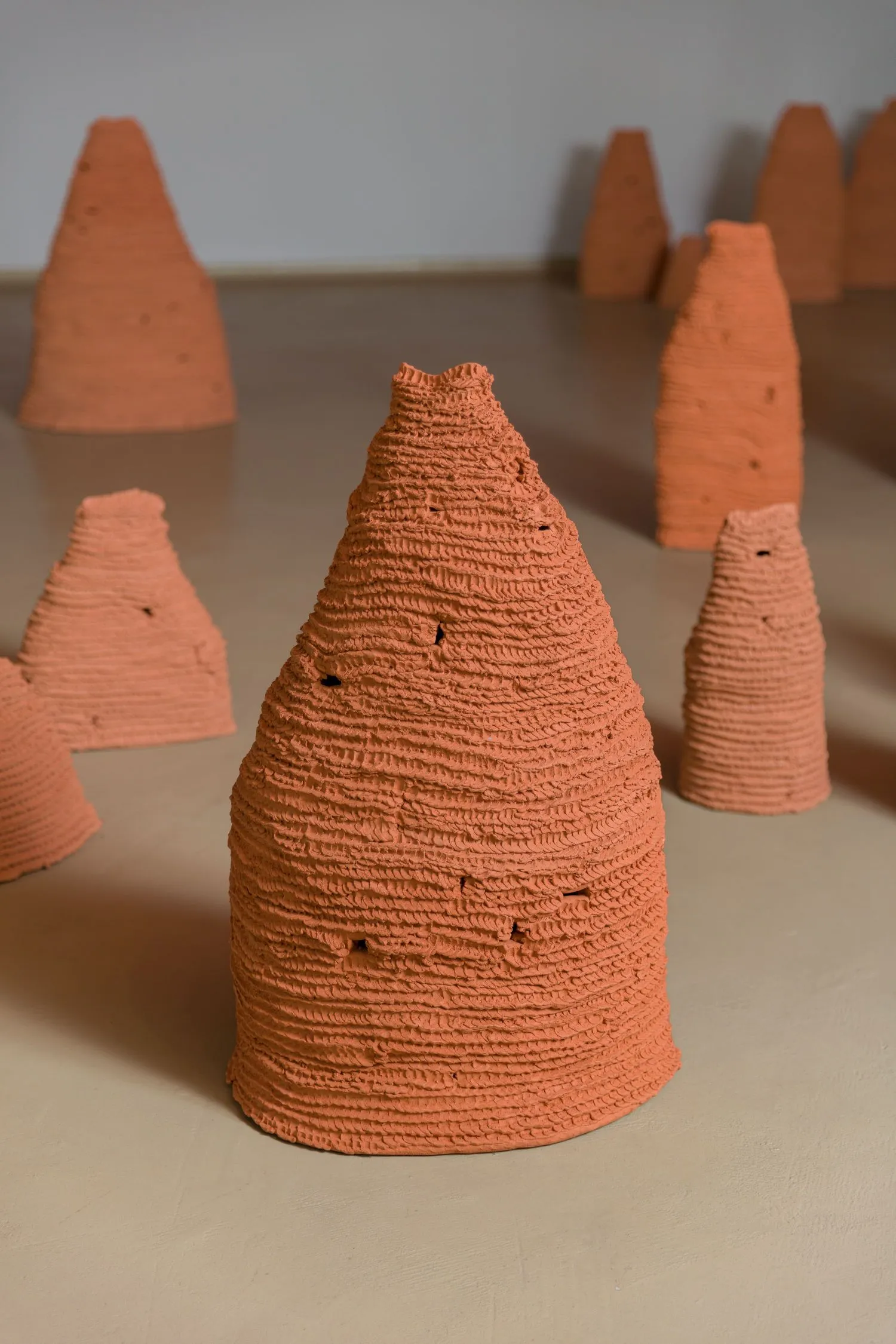
37th Panorama de Arte Brasileira — Sob as cinzas, brasa, Museu de Arte Moderna de São Paulo, São Paulo, Brazil, 2022
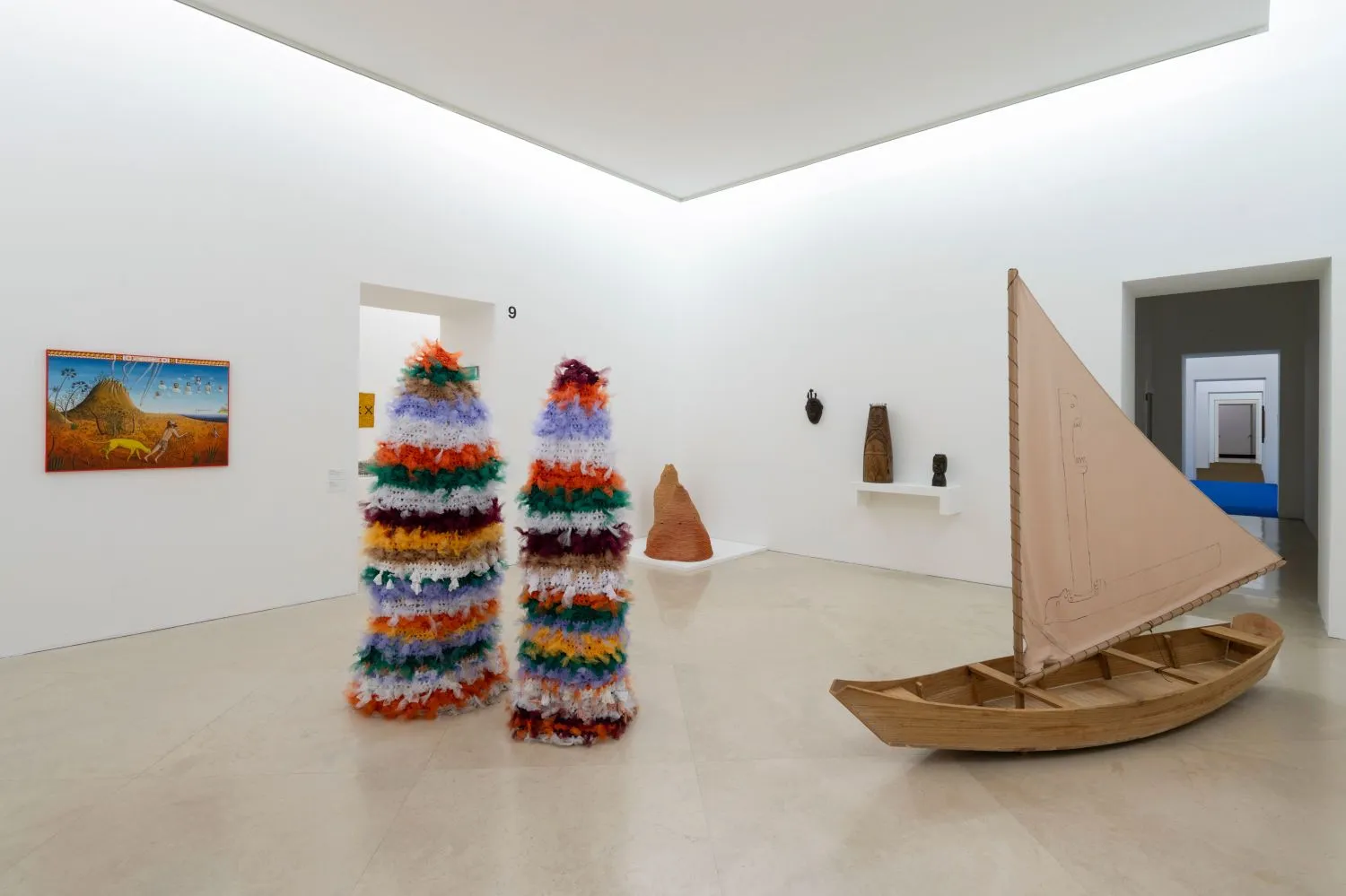
Vai, vai, Saudade, Museo Madre, Naples, Italy, 2024
Watching the way the artist works, shielding herself from external disturbances through this small movement, it’s easy to associate the act of crocheting with chanting a mantra—the repetition of a gesture that can put her in a state of concentration, similar to what precedes a performance or an actor’s stepping onto stage, a kind of trance.
—Cristiano Raimondi and Lucas Goulart
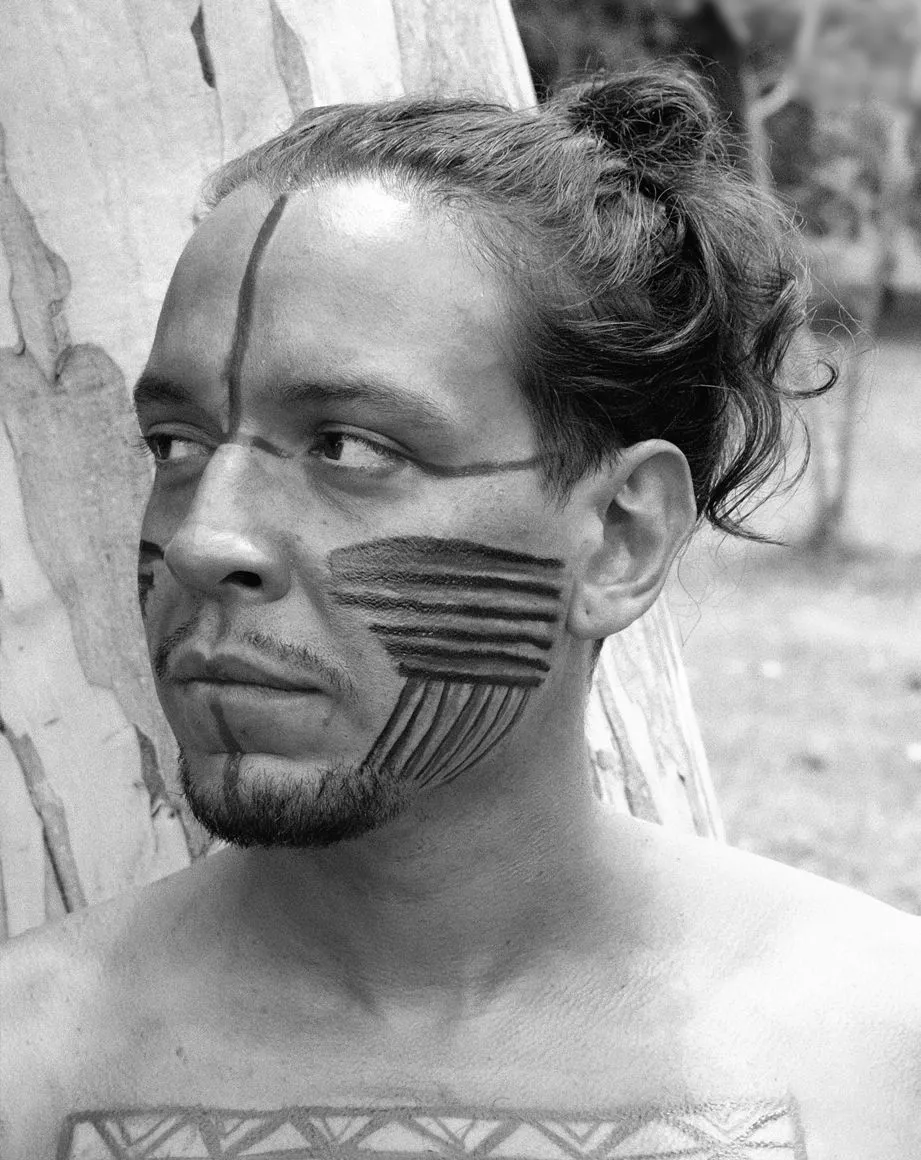
Gustavo Caboco
b. 1989, Curitiba/Roraima, Brazil
Lives and works in Cuiabá, Brazil
Caboco's work explores multiple media, such as drawing, painting, textiles, installation, performance, photography, video, sound, and text. He creates devices for reflection on the displacement of indigenous bodies, the processes of (re)territorialization and memory production.
One of the curators of the Ka'a Pûera Pavillion, the Brazilian representation at the 60th Biennale di Venezia, Caboco has also been leading the Ateliê-Lavrado, stemming from a residency at the British Museum. Recent group shows include Threads to the South, ISLAA (New York, USA, 2024); Festival Theaterformen, (Braunschweig, Germany, 2024); Indigenous Histories, MASP (São Paulo, Brazil, 2023) and Kode Stenersen Museum, (Norway, 2024). His work was also featured in the 34th Bienal de São Paulo (Brazil, 2021).


Debaixo do barro do chão, 2024
Acrylic on canvas
150 x 186.5 cm [59 x 73 ½ in]

Makunaimas viram pedra na Serra da Lua e o campo invisível das traduções, 2023
Acrylic on canvas
153 x 280 cm [60 x 110 in]

Ouvido da terra, 2024
Acrylic on canvas
156 x 190.5 cm [61 ½ x 75 in]
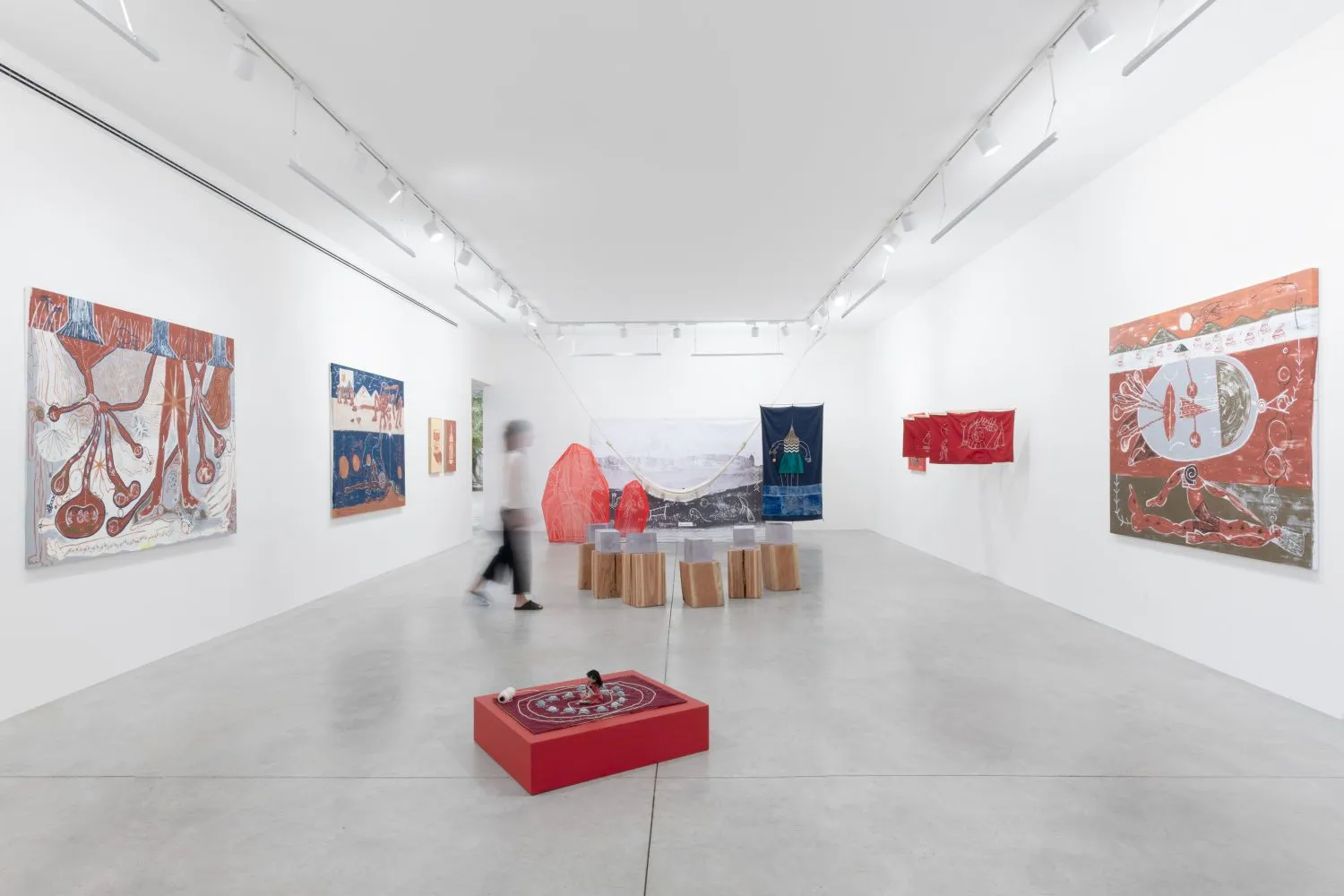
Manhaba’u: onde toca o invisível, Millan, São Paulo, Brazil, 2024
The Earth, this blue dot in the cosmos, is our home in space and our common ground. A living organism, the Earth is a thinking being that interacts with all of its sons and daughters. [..] The creation of the duality, “human” versus “nature,” is what prohibits us from seeing that we ourselves are the ones harming our health whenever we continue to disturb the Earth’s health. Everything is consumable, resource, raw material. Even this text. The urge to consume, which also spurred the Portuguese, the Dutch, the English, and the Spanish ships in their quest to colonize continents and resources, is the same ship that searches for life on other planets. It is the same ship that created extractivist beings and researchers. Or what else are we humans seeking on Mars?
—Gustavo Caboco
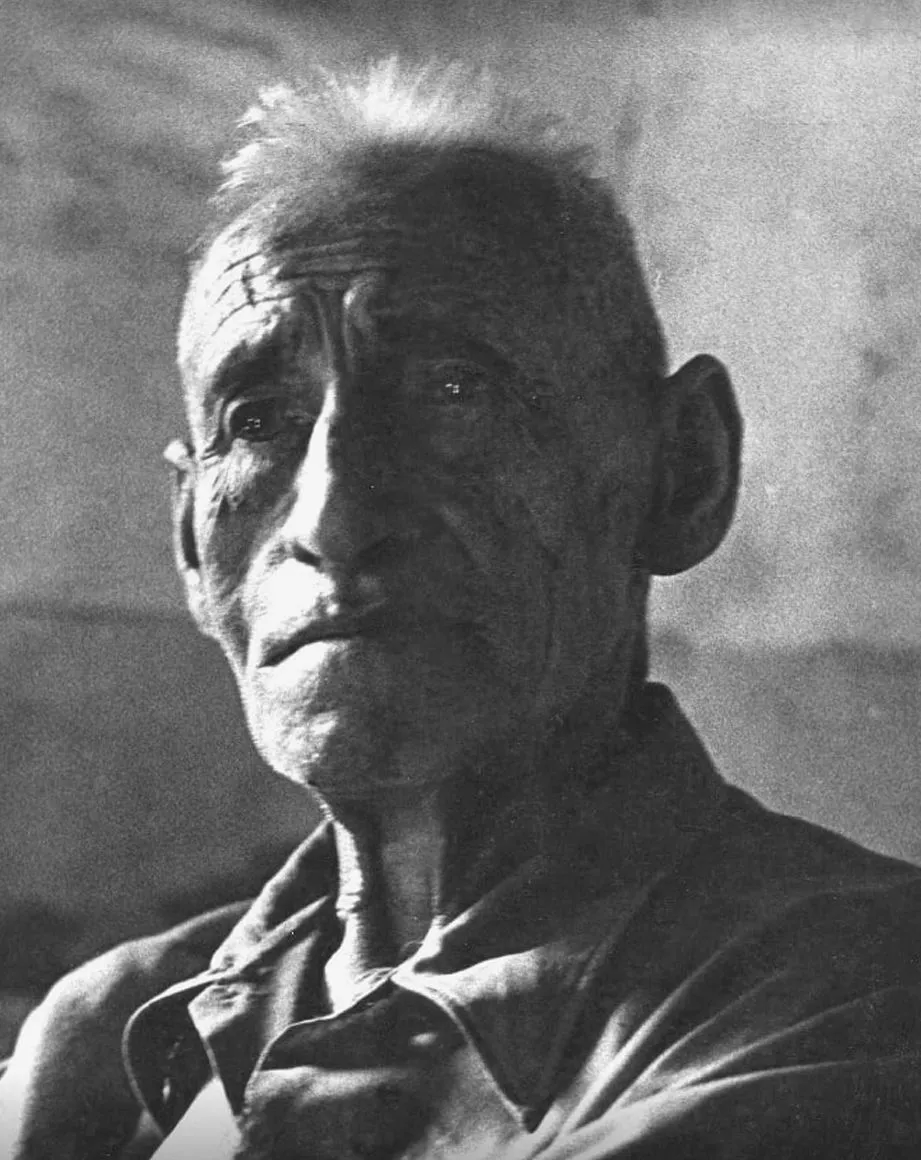
Amadeo Luciano Lorenzato
b. 1900, Belo Horizonte, Brazil
d. 1995, Belo Horizonte, Brazil
Lorenzato painted mainly rural and suburban landscapes. His canvases often display observations of nature, incipient urbanization and everyday life. They also are indicative of his working-class upbringing, seen that Lorenzato developed unique techniques in which metal combs and other tools — often unrelated to the craft of painting — were used for texture and color treatment of the canvas.
Recently, Lorenzato's works were featured in Stranieri Ovunque – 60th Venice Biennale (Italy, 2024); Brazilian Histories, MASP (São Paulo, Brazil, 2022). His work has also been subject of solo shows in New York, USA (2024), Hong Kong (2024), and London, UK (2019). His works are part of collections such as the Museu de Arte da Pampulha, MASP, Pinacoteca de São Paulo, and the Nouveau Musée National de Monaco.

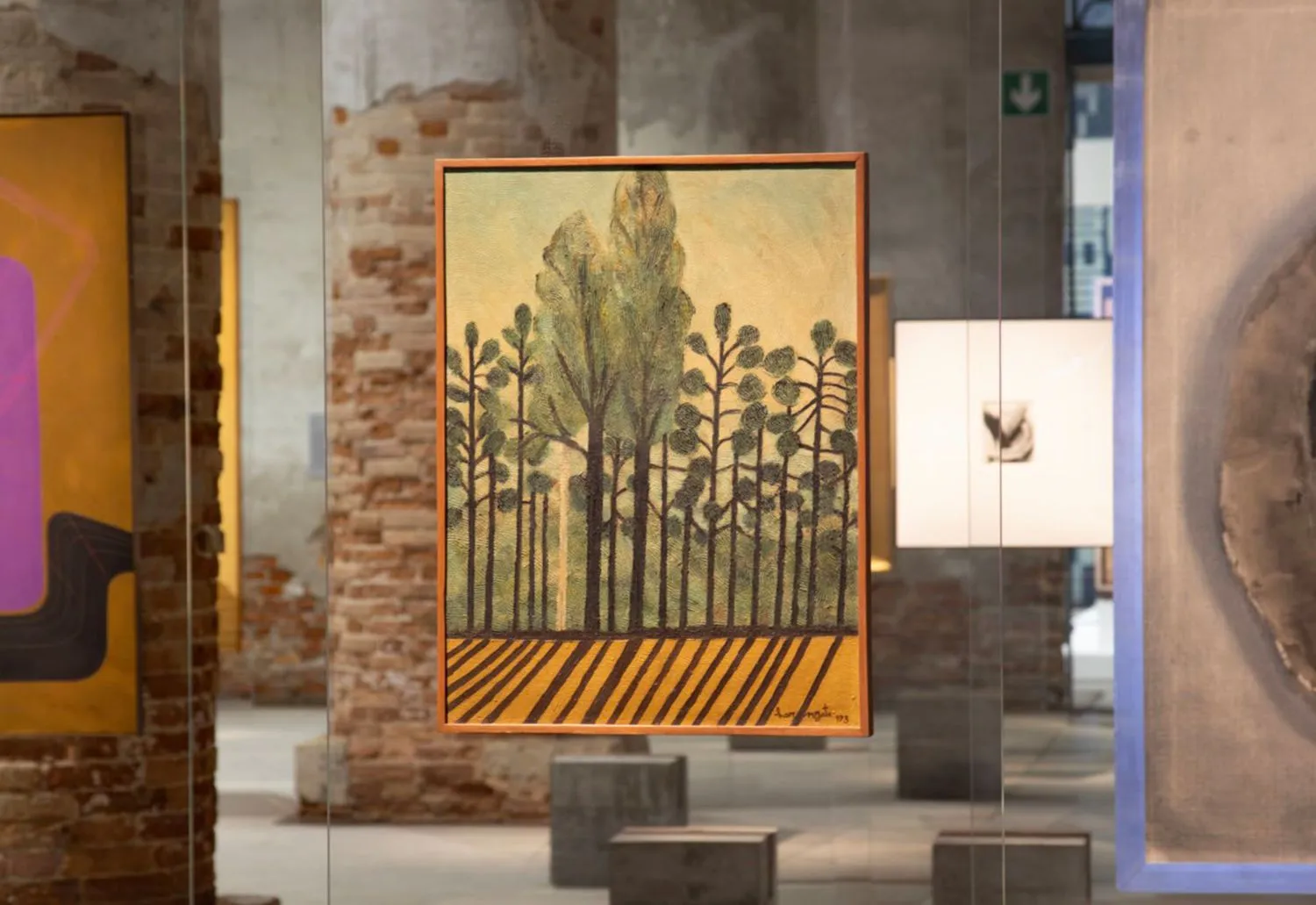
60th Biennale di Venezia — Foreigners Everywhere, Venice, Italy, 2024
Painting with the comb, incisively or delicately, in a continuous or interrupted movement, circular or rectilinear, the artist breathes a kind of vital élan into the entire surface of the paintings, oxygenating it.
—Laymert Garcia dos Santos

